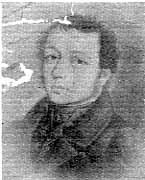
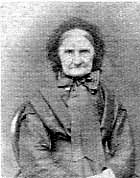
Grandfather Bertholdt
Neustadt a/A
Grandmother Bertholdt
Neustadt a/A
My ancestors on my father's side came originally from Upper Austria where they were foresters, taking care of the immense forests of Count Schwarzenberg, but toward the end of the thirty year war (1618-1648) they were driven out by the Austrian Emperor Ferdinand, who went up north to fight Gustav Adolphus, who was at the head of the Protestants. My forefathers, being staunch Protestants, found refuge in Franconia, under the Margrave of Brandenburg-Bayreuth, who was glad to take them in, as his whole territory had been depopulated during the long war. There was scarcely a city or village which was not at least partially destroyed; especially the churches and monasteries had suffered and the Protestants were more destructive than the Catholics, in that they demolished not only the buildings, but priceless pictures and statues with which the monks had adorned them. The Catholics wanted their church beautiful, decorated with gorgeous paintings, statues and stained glass windows, whereas the Protestants were content with bare walls.
My ancestors on my mother's side, the Bertholdts, had always lived in Franconia, in the Valley of the Aisch, a small river flowing into the Main.

|

|
|
Grandfather Bertholdt
|
Grandmother Bertholdt
|
I do know, however, that my father's father was a builder, being especially noted for erecting churches and other large buildings which had been destroyed during the long wars. He sent my father, John Leonard Saegmuller, to the then University of Altorf, where he prepared himself to enter the Government Educational Department. He was born in 1812 and one of his first positions was as a teacher in Dettendorf, a small suburb of Neustadt. There he met my mother, Babette Bertholdt, daughter of Michael Bertholdt, who lived in the City of Neustadt, a/A, (on the Aisch). My father's father was born in 1799 and died in 1845.
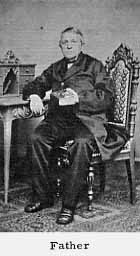
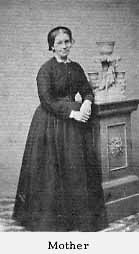
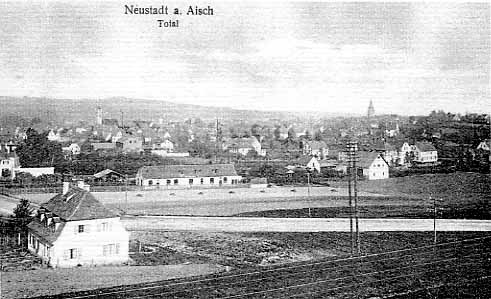
Neustadt was famed for its hops which grew on the surrounding hills and were eagerly sought by buyers of hops for breweries. The various fields of the owners were scattered all around the hills, an acre or two here and other small parcels perhaps a mile or two away. To cultivate and finally harvest the crops was no small task, made doubly difficult by the distances that the fields were from each other. After the hops were ripe they had to be picked from the stems by hand and spread out on the floors of the large garrets in the homes. This required special care to keep the hops from losing their aroma. I recall, as a small boy, long after we had moved from Neustadt, how the pickers came from all over the country, and how the hops had to be turned about every day until they were entirely cured. The price of hops varied from year to year, according to quality and supply, from 100 to 200 Gulden per hundred weight. In that small town, populated by farmers and tradespeople, my grandparents lived, and there it was that my mother and father married a year after the death of my grandfather, in 1846. It was there that I was born on the 12th of February, 1847, but soon afterward my father was promoted and we moved from place to place until we finally settled in the large village of Uttenreuth. Uttenreuth had a large school, the children of three or four neighboring villages having to attend it. The village of Uttenreuth, situated about an hour's walk from the University City of Erlangen and three hours from Nuremberg, was really my boyhood home, as I do not remember anything of the other places where we lived prior to this. I do not recall the year we moved there, but I do know that it was not long after that I entered the Technical School of Erlangen.
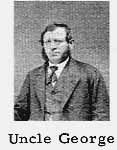
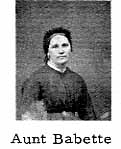
My father's mother lived with us in Uttenreuth and died there. She occupied her time chiefly in the garden and took little notice of us, as she was very deaf. It may be that I have inherited this malady from her. My maternal grandmother lived to a ripe old age in Neustadt, where she occupied the upper story of my uncle George's (mother's brother) house, my uncle occupying the balance of it. My brother and I frequently visited her, walking from Uttenreuth to Neustadt, a distance occupying an entire day's travel. I do not remember when it was that she died, but know that she was very old. Her maiden name was Ostermeier and she came from a small city by the name of Emskirchen, situated between Neustadt and Nuremberg. The only relative that I knew who still lives in Neustadt is my cousin, Babette Edelmann, a widow now over 80 years of age. Mrs. Saegmuller and I visited her when we were last in Europe and previous to this I visited her with my son George.
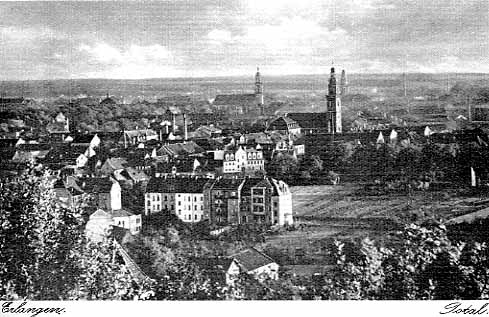
Regarding my school days and before describing the Technical School in Erlangen (Gewerbeschule) I want to give an idea of the school system as it then existed in Bavaria. Every child had to enter school at the age of seven years and remain in school for six years. After confirmation, those wishing to enter higher schools, such as the Technical or Latin Schools, had to pass an examination. If they passed - and the examinations were quite severe - they had to remain in the Technical School three years and in the Latin School four years, and here again they were promoted only if they passed a severe examination. Having graduated from the Technical School, they were privileged to enter the Polytechnic School in Nuremberg. The school hours were from 8 to 12 and one-half hour intermission at 10 o'clock, and from 1 to 4 in the afternoon. As I had to walk from Uttenreuth to Erlangen, which occupied about one hour (in Germany at that time distances were given in hours, not miles) my brother and I (he joined me two years after I had entered the school) had to get up at 6 in the morning, and after eating breakfast, consisting of bread, without butter, and coffee, we started for school. This was all very well in good weather, but in the winter, which generally set in on Martin's Day (November 11th), with the first fall of snow, it was necessary for me to leave the house at 6:30 o'clock in order to be in time for school, which began at 8 o'clock. Sometimes it was necessary to wade through snow a foot deep, nobody having gone over the path before, but in the three years that I attended the school I never was late nor did I miss one day. My father having taught me, at a very early age, to read and write, I was about two years ahead of the other scholars, who, when I was 11 years old, were 13. I made good headway and passed every year and each year received a prize. The prizes consisted of books, and I am very sorry that, in the course of time, these books were lost. For dinner I received One Groschen - about 2 cents - and a piece of bread. With the money I was expected to buy a bowl of soup, which, however, I did not always do. The only complaint I could register against the technical schools was the fact that we had so many lessons to do at home, otherwise, I could not speak too highly of them. We were taught Algebra, Geometry, Stereometry, Chemistry, History, Geography, English and French; in the second year Trigonometry was added. I regret very much having lost my school books which I carried with me for years and which contained all my lessons and the answers, neatly written and constituting a record of the whole year's work. It contrasts very favorably with the loose leaf methods practiced these days, where each lesson is done on a loose sheet and easily lost in consequence.
The head of the school was Dr. Reinsch who taught Chemistry and Physics, but of all the teachers I liked Mr. Rupelius best. He was quite a young man and was not only our teacher in Mathematics, but was also at the head of the little Machine Shop which was a part of the school. He took a liking to me as I was his best scholar in Trigonometry and I assisted him in the machine shop where he was building a little steam engine. When the time for my graduating was near he asked me what I intended doing and I told him that I wanted to become a mechanical engineer and go through the Polytechnicum in Nuremberg. When he heard that my father had made arrangements with a mechanician who ran a small machine shop and that I was to attend the Polytechnicum only as a "hospitant" to take mathematics, he went, on his own accord to Nuremberg and saw Prof. Bauschinger, a friend of his, who was at the head of the mathematical department and also had charge of the machine shop connected with the Polytechnicum. He recommended me highly to Prof. Bauschinger and arranged that I was to take the full mathematical course and by giving Schuler - at whose shop I was to learn the practical part of a machinist - considerable orders, I really spent more time at the Polytechnicum than at Schuler's. Soon after I entered there Mr. Rupelius died; a very young and talented man, the memory of whom I shall always cherish.
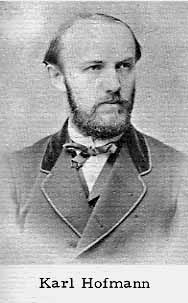
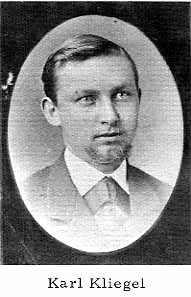 It will be seen by the long school hours that there was little time for play.
We had Saturday afternoons free, and of course, Sunday, when I spent my time
with my two boyhood friends, Karl Hofmann and Karl Kliegel. The former was the
son of the village doctor and the latter the son of a brewer. Karl studied
medicine, and in 1889 I paid him a visit in a small city near Nuremberg, where
he practiced as a successful physician. He died a few years later, leaving his
considerable savings to his sister Emily, who, after the death of her parents,
lived alone in the old homestead. During the inflation period she lost all of
her property and I was indeed glad to be able to come to her assistance during
these trying times. My friend, Karl Kliegel, became a successful brewer and
farmer and finally went into politics. He became Land and Oeconomie-Rat and died
as such only a few years ago. I paid him a visit each time I went to Europe and
he was always pleading with me to do something for Uttenreuth. I endowed a
Children's Asylum in honor of my Father, but unfortunately most of the capital
was swept away by the inflation; before this I had given them two stained glass
windows for the Church and a railroad siding.
It will be seen by the long school hours that there was little time for play.
We had Saturday afternoons free, and of course, Sunday, when I spent my time
with my two boyhood friends, Karl Hofmann and Karl Kliegel. The former was the
son of the village doctor and the latter the son of a brewer. Karl studied
medicine, and in 1889 I paid him a visit in a small city near Nuremberg, where
he practiced as a successful physician. He died a few years later, leaving his
considerable savings to his sister Emily, who, after the death of her parents,
lived alone in the old homestead. During the inflation period she lost all of
her property and I was indeed glad to be able to come to her assistance during
these trying times. My friend, Karl Kliegel, became a successful brewer and
farmer and finally went into politics. He became Land and Oeconomie-Rat and died
as such only a few years ago. I paid him a visit each time I went to Europe and
he was always pleading with me to do something for Uttenreuth. I endowed a
Children's Asylum in honor of my Father, but unfortunately most of the capital
was swept away by the inflation; before this I had given them two stained glass
windows for the Church and a railroad siding.
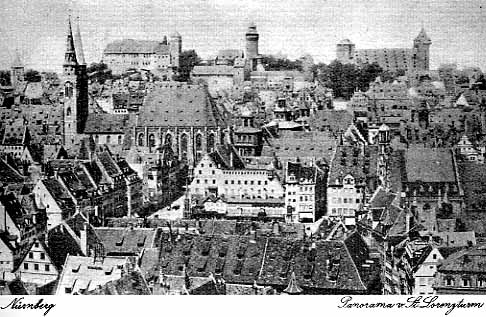
After I passed the Technical School in Erlangen, I attended the Polytechnic School in Nuremberg, where I spent two years of the hardest time of my life and I can't help thinking that my father made a big mistake, but someone persuaded him to put me in the hands of a practical mechanician, where I was to lodge and from where I was to go to the Polytechnic School each morning. I had to be up at 6:30 and after partaking of a very meagre breakfast, I had to sweep the floor and put everything in order. In the afternoon I had to do practical work. Mr. Schuler had but one assistant and one other scholar, like myself, and I think he was always glad when I went to school.
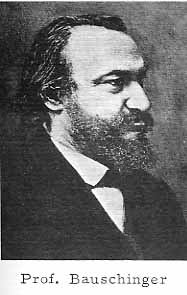
There, fortunately, I became acquainted with the great mechanical engineer, Bauschinger, who acted as Assistant in Nuremberg before he became professor in Munich. He was quite an inventor, but lacked the mechanical practice to make his own apparatus. I was very glad to be of help to him in this direction and made quite a number of parts for his apparatus at Schuler's. I remember once we fastened a mirror to the central span of a railroad bridge and noticed the reflection of a distant scale through a telescope, showing the vibrations. He was very much elated when one morning I brought the whole apparatus to him which I had made at Schuler's., From that time on I became his constant assistant and it was he who helped me in graduating from the Polytechnic School in two years instead of the regular three. I told him how poor my father was and that he could only pay 200 Gulden for two years at Schuler's. He pushed me ahead in mathematics and I am more than sorry that I lost the lessons which he gave me along with my answers, which were far ahead of the usual curriculum. I visited him in Munich in 1889, a short time before his death, and he was more than pleased when he heard how I had progressed. The time passed quickly in Nuremberg; I had scarcely any money and no acquaintances, but occasionally my Aunt Sabine, who had married a well-to-do confectioner and proprietor of a mineral water factory, Andrea Beer, gave me a few groschen and my daily dinner, but I did not like to spend my evenings there as she had a number of small children and wanted me to take care of them. It was far pleasanter to work for Prof. Bauschinger and assist in perfecting his inventions. While I studied hard I spent my holidays at home, walking through the Nuremberg forest about three to four hours to Uttenreuth.
After my graduation I became acquainted with two Englishmen, who brought about quite an important turn to my life. A cotton mill had been erected in Erlangen and the machinery imported from England. Two engineers, Chadwick and Newton, were sent to put up the machines, and knowing nothing about the German language they were often in great difficulties. I don't remember how they happened to hear that I could speak English and in consequence visited our house in Uttenreuth one Sunday afternoon. I had studied English for three years in Erlangen but had given it up in Nuremberg in order that I might hurry up my other studies to enable me to graduate in two years' time, but I remembered enough of the language to understand them and make myself understood and was engaged as their helper at the rate of, as I remember, a Gulden per day. To me, who had never owned a penny, that was indeed a windfall, and I went to work with a will. As these Englishmen had the erecting of the machinery in contract they started very early and worked until late. I had to be there from six in the morning until seven at night, and in order to save my money I walked back and forth from Uttenreuth to Erlangen. This I did for about a year and then started for England, having saved all my money to meet the expenses. Both Chadwick and Newton invited me there and promised me a position in their factory--Platt Bros., Oldham. On my way to England I spent a few days at the hotel of my uncle in Frankfurt and came away with a gift of a few gold pieces and went by way of Ostend to London, there to call on my brother, who had been taken in charge by my Uncle John, for the purpose of fitting him for the hotel business. He had just come from Lausanne to London and worked at the Langham Hotel.
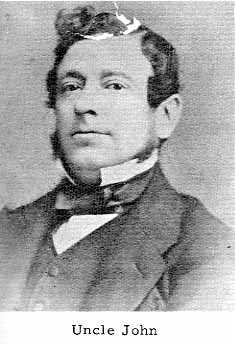
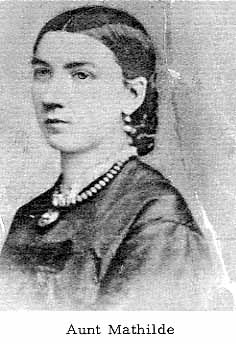
After spending a few days with him I went to Manchester and Oldham, which is only about 10 or 12 miles away. I was received very friendily by the Chadwicks - Newton was abroad - and was taken to the Platt factory. I did not like it at all and told Chadwick that I would try to get into a machine shop and do either drafting or calculating. The first thing I did was to look for a room and I was fortunate in finding board and lodging in a very nice little house occupied by an Irish family by the name of Brennan. The man gave me the names of several machine shops where I might make inquiry for work. The first one was the celebrated Whitworth, but there I found that there was no vacancy. I next called on Muir & Company and was taken on. They made chiefly tools of a high grade, such as lathes and planers. One man made machines for the counting of railroad tickets and to this man I was assigned as a helper. I do not remember how much I earned, but I do remember that it was just enough to keep me, and here I must confess to the first mistake that I made in my life. The Brennans had been very good to me and I had no reason at all for leaving them, but there was a young man by the name of Robert Kilgour, who assisted me in the work on the counting machines, and it was due to his influence and persuasion that I left this nice family, whom he described as Catholics and Fenians, and took room with him. This was a very despicable thing to do and I have regretted it ever since. Long afterward, when I went to Manchester on a visit, I tried to locate them for the purpose of begging their pardon, but they had moved and my search was in vain.
One day I saw an advertisement in the papers that Thos. Cooke & Sons in York were looking for experienced mechanicians. I called there and this move was one of the most fortunate ones I ever made in my life. Cooke & Sons manufactured not only Telescopes and other Astronomical Instruments, but also Surveying Instruments, Tower and Astronomical Clocks. Mr. Thos. Cooke was originally a schoolmaster, but took up surveying and one of his first jobs was surveying the railroad from York to Scarborough, At that time the engineers were very particular to avoid grades and the York-Scarborough road is almost level When Mr. Cooke finished this work he started a small shop in York for the manufacture of surveying instruments and also dabbled in optics. He made a 4-inch objective which proved to be a very good one (one of the lenses was made out of the bottom of a beer glass). Gradually he built larger telescopes and Prince Albert, the husband of Queen Victoria, became one of his patrons, and through him he received large orders for the Indian Survey, which had just been undertaken. However, he lacked skilled labor and tried all means toward obtaining "Feinmechaniker" (high class mechanicians) such as Repsold employed, who at that time turned out the finest class of instruments. He succeeded in procuring the services of Mueller, who for years made nothing but large Theodolites for the Indian Survey. Buff & Berger were also engaged in this kind of work. Gradually the works grew; with the making of larger telescopes he also combined the building of domes. Then the Tower Clocks were added to the line of manufacture.
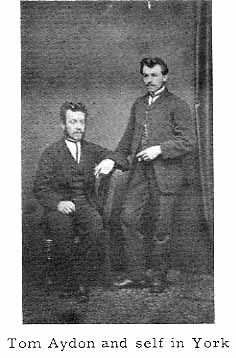
Mr. Cooke had four sons; Fred Cooke was the mechanician; Alfred had charge of the fine mechanics; Tom was in charge of the optical department and Edwin Cooke had charge of a large store on Cooney Street in the city. When I called at Cooke's, Fred Cooke asked me what I could do and I told him that I could draw and calculate and also do practical work and if he would give me an idea of what he wanted I would show him what I could do. At that time they had no Dividing Engine and fortunately I had sketches of Reichenbach's machine which Prof. Bauschinger had given me. In addition, I was fully acquainted with the methods Reichenbach employed to produce his wonderful graduations. Reichenbach was the partner and mechanical head of Frauenhofer and Utzschneider and his graduations have never been excelled. After explaining all this to Mr. Cooke he told me to go ahead and make the working drawings. He was pleased and I was told to go on. He gave me more help, among others my later friend, Tom Aydon. We finished the machine, which had a circle of 30 inches diameter, within a year, and it gave very good results. At first it was worked by hand but Fred Cooke showed me a picture of the Ramsden machine which worked automatically and I built the Cooke machine very much after the Ramsden. It performed very satisfactorily up to a certain size of circle, but the large 10 and 12 inch Theodolites for India I copied by hand, as automatically we derived errors up to 30 seconds. A second larger engine was planned and I made all the drawings for it, but it was not finished when I left York about three years later. At that time old Mr. Cooke took some interest in me. The firm had just received an order for a large Meridian Circle for Mr. Newall. He was the maker of the first Atlantic cable and took great interest in Astronomy. Cooke and Sons were finishing a large Equatorial at that time, having an objective of 25 inch diameter, the largest then in existence. Dr. Marth was Mr. Newall's astronomer and was a frequent visitor at the works to inspect the Equatorial and the Meridian Circle which was then in work. He was in doubt whether the firm could give him a graduation which would at least equal Repsold's Meridian Circle which had then just been finished for Besel in Koenigsberg. Mr. Cooke took Dr. Marth into the small building where I worked on the Dividing Engine and had me explain how Reichenbach made his wonderful graduations. He became satisfied that we could do the work and it progressed far enough so that the Meridian Circle was nearly finished when I returned to Germany. The elder Mr. Cooke would test all larger instruments on stars at night and as he could not handle them very well alone, he would ask one or two workmen to assist him. He soon found out that they not only charged him for the actual time they spent with him, but doubled the hours on account of it being night work. Mr. Cooke then disposed of their services and I offered to help him. This was a pleasure to me as I was able to learn a great deal from this gentleman and he was very much surprised when he found that I asked no remuneration for my services. When he spoke to me about it I told him that I profited more by seeing him test the instruments. After that time he became very friendly with me, increased my pay, and I feel reasonably sure that if he had been alive when I came back from Germany, where I went to serve my time in the Army, I never would have left for America.
When I came to York both Buff and Berger had left for America and there was only Mr. Mueller, Tuckermann and myself left of the original German colony, but we all occupied favored positions. We were often invited to Mr. Cooke's home to spend the evening, although even then Mr. Cooke frequently took me away to assist him in manipulating some large instrument which was ready for shipment. I preferred the instructive conversation with this kindly old gentleman to drinking tea with Mrs. Cooke and her daughter.
The life in York passed very pleasantly, in fact, I consider the four years spent there as the pleasantest years of my life. I had become acquainted with a gentleman who kept a book store, a Mr. Henry Chapman. He was very eager for knowledge, especially desirous of learning French and German and it was not long before he invited me to his home, where we spoke German and French, a young Frenchman also being present on these occasions. On Sunday we would take long walks together and in this way passed the time very pleasantly. On Saturday afternoons, however, a party of young men from the shop would take a boat ride on the river Ouse, going a distance of about four miles, to a place called Bishopthorpe, the seat of the Archbishop of York, where we would visit a beer garden and pitch quoits. These were lens-shaped pieces of iron which were thrown toward an iron pin protruding from a layer of clay. A penny was placed on the pin and the one hitting it would win it. The other quoits would fall around the pin and these were carefully measured as to distance. This game we often played away into the night, using candles to light up the pin as well as the quoits. We would then row back to York, which, however, was an easy task, as we were going down stream with the current. We would go to the "Elephant and Castle" where we had some supper and drank a couple of glasses of rum with sugar and water. Of course the winter time put a stop to this sport, but Mr. Fred Cooke had interested quite a number of the mechanicians and proposed to build a steam carriage which was to become the joint property of all who helped build it and all could ride in it. It was a cumbersome affair and an old law compelled us to have a man with a red flag precede us until we were out of the city. We scarcely ever came home in it, as we generally had a breakdown and had to send the car back by rail. The last time I went with it we went to Lincoln, but in returning the axle broke and a lady broke her arm. Here ended the steam carriage rides.
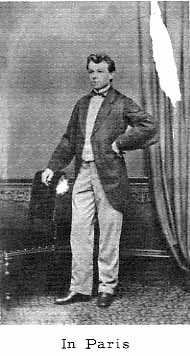
A very nice compliment was paid me and I know that old Mr. Cooke was responsible for it. Cooke & Sons prepared quite an exhibit for the Paris Exposition in 1867 and I was selected to be in charge of it because of my knowledge of French. I spent ten delightful months in Paris. My brother was there at that time, at the Hotel Meurice, one of the finest hotels on the Rue de Rivoli, opposite the Tuileries, and we often came together. I saw the Emperor Napoleon, Czar Alexander, King William and Bismarck and a lot of other celebrities. The most brilliant fireworks I have ever seen I witnessed there and this reminds me of another display of fireworks which I saw while in York. I have forgotten the year, but it must have been either 1867 or 1869, when the earth passed through the Leonides. This happens every 33 years. The whole sky was filled with shooting stars, like rockets shooting in every direction. I was at Mr. Chapman's house at the time and I think this wonderful display lasted over two hours. This is about all I remember of York, except that every Whitsuntide we made use of the cheap excursions to Scotland, Ireland and the Isle of Wight, as well as the beautiful lake regions. These excursions showed me what a beautiful country England really is. I forgot to say that every Sunday evening we went to the old Minster to hear the music.
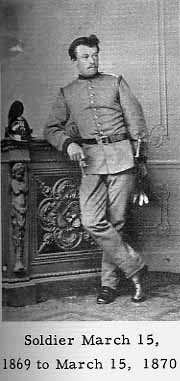
I disliked very much leaving England, but duty called me home. At that time every German had to serve in the Army and the Prussian system had been introduced in 1868, after she had defeated the South Germans in 1866. The Prussian system requires that every able bodied young man serve three years in the Army, two years of which time are spent in the barracks, while, during the third year, the soldier is on furlough and only called for a short time for maneuvers, or in case of war. Those who can pass a rather severe examination and are able to clothe and board themselves need serve only one year, when they become officers in the Landwehr (Militia). These young men are instructed by specially appointed officers who devote their entire time to this duty and every regiment has 36 "Einjaehrig Freiwillige" (one year volunteers), three in each company. The time of entry is the 15th of March every year and the examinations occur during the month of February. In order to prepare myself somewhat and to be in time to have my uniform made - and also my desire to spend Christmas at home after having been away for so long a time - I left York about the middle of December 1868. It was with no little regret that I left my good friends, such as William Wilkinson, a lame lawyer's clerk, and Tom Aydon, my shopmate who worked with me on the Dividing Engine, as well as a host of others with whom I had not been so intimately acquainted. I am ashamed to have to confess to another act for which I have been sorry since, although in reality it was not my fault. Before leaving I went to Mr. Waite, who had been making my clothes all the years I lived in York, and told him that I was going home to serve my time and that I wanted a new overcoat. I told him that I would come back in one year and pay for the coat, but that I was quite sure my brother would pay for it in the meantime; that I had enough money to pay for it, but that no doubt my trip and outfit would take the greater part of it. He agreed quite cheerfully and I immediately wrote my brother relating the circumstances and asking him to take care of it. I think it amounted to 3 or 4 pounds and he wrote back that he would settle the bill. The matter passed from my mind until many years later when he wanted money from me and which I gave him with the request that he render an accounting. When I received this I noticed that there was no charge against me for the Waite bill and upon inquiry found that he had not paid the bill. I was very angry and took every step to get in communication with Mr. Waite, but all my friends in York were dead and perhaps he too had died. Later on, I wrote Mr. Brand, who was the manager of the Bausch & Lomb Optical Company's London Office, asking him to look up this Mr. Waite or his descendants and give him 10 pounds and my excuse for not having paid the bill. I never heard from Mr. Brand and don't know how I can make restitution in this matter. Perhaps an advertisement in a York paper would help; however, I shall pay that debt somehow.
In order to save money, I decided to sail from Hull to Rotterdam on a freighter carrying passengers. Of course, the best way would have been to go to Dover and cross over to Ostend, but it would have been much more expensive, so I went to Hull, found my steamer and also another passenger who went to Arnheim, near the Holland frontier. This fellow smoked and drank rum all the evening and when the steamer sailed at midnight it did not take him long to get rid of all he had taken. In fact, he was sick all the way across and when we arrived in Rotterdam, after midnight, I asked him to come with me to a hotel and get out of that horrible atmosphere, but he thought it would be all right, as the ship was tied to the wharf and he would meet me at the station at 10 o'clock the following morning. I took my bag and soon found a small hotel, which had a nice, clean appearance, and there I asked if I might have some supper and a bed. They took me into a back room where a table was laid for supper and in this room there were hundreds of small cages with canary birds in them, and these little creatures no doubt also wanted their supper, as a man was throwing grain through the crates for them to eat paying no more attention to the fact that I was there and having my supper in the same room than if I were not present. After finishing my meal I went to bed, climbing into same by means of a ladder, and the next morning, after breakfast I went to the station. There I found my traveling companion who woefully cried out "I wish I had gone with you; they commenced unloading rails which knocked on the side of the ship where my bunk was and I could not sleep a wink". We parted ways at Arnheim, where he stopped, and I continued my journey along the Rhine to Frankfurt. I stopped for a couple of days at my Uncle's and then, by way of Neustadt, I went to Erlangen. It did not take me long to get to Uttenreuth, where they expected me, as my Uncle John had written that I was coming. The reunion, after an absence of five years, I shall never forget. With the exception of my brother John we were all together, and of course I had to relate all my experiences and there were no end of questions, but everything seemed to have grown smaller to me than I had imagined them to be; the trees, the houses all seemed to have shrunk, but not the love of my dear mother, who often, during the night, came into my room. She was anxious about the examination I had to pass in order to enter the one-year volunteer, and she was very anxious too about the great cost that this year would entail. I had some money but she said that this would not be enough. Unbeknown to me she went to my Uncle George in Neustadt, with whose wife she was very friendly, and quite joyfully she told me that they would help me out. Although they regarded this as a gift, I repaid every cent. After the holidays, and after I had visited all my friends in Uttenreuth, Erlangen and Nuremberg, I went to the latter city and reported to the military authorities. The examinations were held in the middle of February, I believe, and lasted four days. I have kept the full record of these proceedings and am sorry that they were lost in the fire when the house in Virginia was burned. Of course, I could speak both English and French and in mathematics I had, fortunately, just brushed up that part which was given for examination. I was not quite so lucky in History and Geography, but due to my good showing in the other subjects I came out as second in a crowd of over one hundred. The examination was held in the big Rathhouse saal where the great banquet was held in memory of the peace of Schmalkalden some 200 years before. Now I was free to enjoy myself as our service did not commence until March 15th, 1869. Meanwhile, I ordered my uniforms and although I had the right to enter the artillery, I chose to enter the 14th Regiment of Infantry. I had no money to buy a horse. I also looked around for a room and was lucky to find a very nice one opposite the "Schoene Brunnen" on the Center Market. For six weeks, however, we had to live in the barracks "Deutschhaus Kaserne" opposite my Uncle's store. I was assigned with two other "Einjaehrige", Eckstein and Canstetter to the 9th Company.
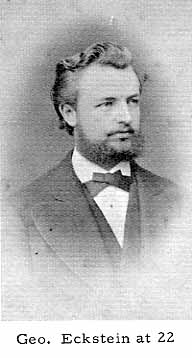
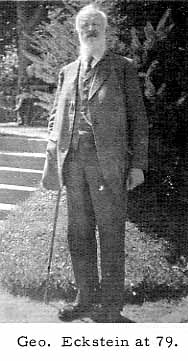
Eckstein and I became great friends and this friendship lasted until his death over a year ago. The 36 "Einjaehrige" were instructed by two First Lieutenants, von Kammerlohr and Guenther. We went through the whole Manual and then were distributed throughout the regiment as corporals, but every day for two hours we had special instructions from the two officers assigned to us as we were preparing for the examination as commissioned officers in the Landwehr. We had the evenings free and friend Eckstein, with some others, including myself, spent them in some of the restaurants and sometimes went to the theatre. In the fall of 1869 we had to take part in a grand sham battle, which lasted nearly a week, in the Main Valley. The year passed quickly and on March 15th, 1870, I received my passport - which I still have. Having fulfilled all my obligations I had the right to emigrate, which I did, as otherwise I would have been called in every year for a month for military service. Inasmuch as I intended to return to England this did not suit me at all, as I did not care to lose a whole month - with going and coming about six weeks - besides the traveling expenses to and fro. However, it was not long afterward that I regretted having taken this step.
About the end of March I again left home and by way of Frankfurt, over Ostend and Dover, arrived in London. My first visit was to the London office of Cooke & Sons, where I learned that my great friend - old Mr. Cooke - had died. This was indeed a very sorrowful foreboding and heavy hearted I went back to York and started to work again, but great changes had taken place and I soon saw that I would not remain there. I recalled Buff and Berger, who had left England for America, and that they prospered there, and made up my mind that I would follow suit. By way of Liverpool I sailed for New York on the SS "CITY OF CORK" arriving about the middle of June, and remembering that there was another Cooke man in New York who had come over before Buff and Berger, and that he had a shop in Center Street, I decided to call on him. His name was Werner, and after telling him my whole story, he became very pleasant and I had to tell him all about York and the people he knew there. He had a small shop and made mostly models for patents, as at that time every application for a patent had to be accompanied by a model. Well, I went to work, and the first job I got was the making of a new coal oil burner. After that I had to make the drawings for an invalid chair with all possible movements. I received as a wage $3.00 per day, which was the rate paid a good mechanic in 1870, but I did not like this work at all and saw no chance for improvement. To the best of my recollection I staid one month and saved some money. While walking to my lunch one day I saw that there was great excitement in the streets and the newspaper boys were crying out "Extras". It was the declaration of war between France and Germany, either July 19th or 20th. I went for my passport and as fast as I could run to the German Consul, Mr. Schuecking, brother of Levin Schuecking, the novelist. I had fully made up my mind to return home and enter the Army and applied for passage, but when the Consul looked at my passport, he told me that he could not give me passage as I had emigrated. Having no money to pay for my passage I returned to my room in very low spirits, not caring to go back to work. I lived at the old French Hotel, which was later torn down to make room for the approaches to the first Brooklyn Bridge, over the East River. I did not know what to do and sat in the lobby looking at war news and brooding about my fate. I noticed that an elderly gentleman sat down next to me and regarded me from time to time. There is scarcely a thoughtful man, I dare say, who cannot look back upon his past life and bring to mind some incident, trifling though it may have seemed at the time of its occurrence, but which has nevertheless turned and altered the course of his life. This was certainly the case with me. The old gentleman who took a seat next to me asked me why I looked so despondent. I told him my whole story, that I had recently come from England, where I had spent nearly five years, that I went back to Germany to serve my time in the Army and returning to England found my old employer dead and conditions so changed that I decided to come to America, as some of the mechanicians brought by Cooke from Germany had done and who apparently had prospered very well; that I wanted to return to Germany and enter the Army, but that the Consul could not give me passage. The old gentleman asked me more about my work at Cooke's, and when I told him that I was mainly engaged in building Dividing Engines he said he could give me work if I cared to go to Washington. He told me his name was Wm. Wurdemann and that he had a shop there where he did all the work for the Coast and Lake Survey and Colleges. He told me that he did only first class work and never competed with other manufacturers who turned out cheap work. He was then engaged in the building of a new Dividing Engine and asked me to sketch the general plan of the Cooke engine. He said if I would go to Washington he would give me a letter to his foreman a Mr. Kuebel, and I could finish the drawings for his Engine with some changes which he indicated. He was then on his way to Germany to bring his family back, they having lived in Karlsruhe for several years. I accepted this offer and came to Washington stopping at the Hotel Bismarck on Pennsylvania Avenue.
The following morning I went to the Wurdemann factory, which was located on the hill opposite the U. S. Capitol. The factory was not what I had imagined it would be. It consisted of a small building at the rear of a row of three-story houses, property of Mr. Wurdemann and rented. Besides Mr. Kuebel, his foreman, I found but one man at work. However, I noticed that they were doing fine work finishing some Theodolites and Zenith Telescopes for the Lake Survey. Mr. Kuebel gave me the incompleted sketches for the Dividing Engine. I thought it best to show my sketches of the Cooke Engine to him, but I soon discovered that, while a good workman, he was absolutely devoid of any theoretical knowledge. He showed me how far they had progressed with its manufacture and I found that the base, consisting of tripod, axis and circle, were completed, all, including the axis, made of a fine grade of cast iron. I could not help but admire the axis, which was cylindrical and fitted beautifully in its bearing. Nothing was done to the circle, nor the superstructure carrying the tracing apparatus and the moving screw. I found plenty to do and Mr. Kuebel never bothered me. I asked him many times for his advice, which seemed to please him, but he told me to follow my original sketches which Mr. Wurdemann had approved. Mr. Wurdemann, with his family, returned from Europe by the end of October and he was very much pleased with the progress I had made. He brought a mechanician with him who had been employed at Sickler's factory in Karlsruhe, which factory had made some instruments, particularly levels, for Mr. Wurdemann.
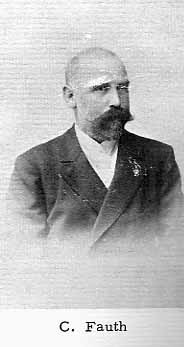
The mechanician's name was Camill Fauth, who afterward became my brother-in-law and partner in business, which we founded later on. As prospects seemed bright and I was tired of living at restaurants I had my sister, Barbara, come over, and I rented a house on Delaware Avenue, not far from the shop. Wurdemann's shop was very frequently visited by officers of the various Surveys and I took particular notice of Prof. Hilgard, the Assistant in Charge, virtually the head of the Coast Surveys. He was very much interested in the Dividing Engine which Mr. Wurdemann hurried up to completion as much as possible. I found out that he had a contract with the Coast Survey for the construction of three Theodolites having circles of 20 inches in diameter for primary triangulation. He guaranteed that the graduation should have no error exceeding two seconds of arc, and I believe the contract price for the three Theodolites was in the neighborhood of $12,000. Mr. Wurdemann's intentions were to finish his Dividing Engine and the three Theodolites and return to Germany, where he would graduate them, and confine his future activities to making graduations of the highest order of excellence. Up to this time the primary triangulation was carried on by means of large Theodolites with circles of over 36 inches diameter. These instruments were made by Troughton & Sims of London and ordered by Mr. Hassler, the first superintendent of the Coast Survey, selected by Thomas Jefferson, who can rightly be called the Father of the Coast Survey. These huge instruments, weighing many hundred pounds, had to be carried up mountains of great height in order to see the distant signals, which, in some instances, exceeded 100 miles. This was a very costly affair and Mr. Hilgard decided to do away with the cumbersome instruments and substitute them with lighter ones without impairing the accuracy. The old English Theodolites were made entirely of sheet brass and tubes, screwed together with hundreds of screws. Thus the new 20 inch Theodolites were a great improvement, as the circles were cast in one piece and the whole construction lightened. On one of Prof. Hilgard's visits to Wurdemann's factory, where he particularly watched the progress of the Dividing Engine, I told him that I could make him a Theodolite of 15 inch diameter which would measure the angles as accurately as could be done with the 20 inch instrument. I also showed him where the construction of the instruments could be simplified and strengthened, so that a 15 inch Theodolite could carry a Telescope as powerful as a 20 inch. This I accomplished (and showed the sketches to Prof. Hilgard) by doing away with the upper plate and its two architectural pillars which carried the Telescope, by casting a U standard, which was immensely stronger than the pillar construction.
As before stated, Mr. Wurdemann had in contemplation returning to Germany taking with him the three Theodolites (on which Mr. Kuebel and Mr. Fauth were employed) and the Dividing Engine, when they were so far completed that only the graduations of the circles were needed. This Mr. Wurdemann intended doing himself by an entirely new method. He was a great believer in levels and the use that could be made of them and it is a fact that he ground by hand the most sensitive and accurate ones of over 1000 ft. radius of astonishing accuracy. I explained the beautiful and truly mechanical method by means of which Reichenbach produced his matchless graduations. Both methods would be worthy of description were it not for the fact that it would require too much space and the use of sketches. Wurdemann continued according to his own method, which, however, did not turn out successful.
As the time for Mr. Wurdemann's departure drew near Prof. Hilgard offered me the position of Chief Mechanician and Custodian of Instruments in the Coast Survey, with a salary, I believe, of $1600, which later rose, by degrees, to $2400. Of course, I accepted this gladly. However, Mr. Wurdemann's removal meant the loss of Mr. Fauth's position, which misfortune was intensified due to the fact that he had, in the meantime, married my sister. We were in a quandary what to do and finally decided to ask Mr. Wurdemann if he would not sell his business to us, as he was preparing to leave for Europe, but his demands were so exorbitant that we withdrew our offer and decided to start a business, in a small way. It was just about at this time that I became acquainted with Rudolph Reichmann and Albert Siebert, as we took our meals at the same restaurant - Charles Mades on 3rd Street and Penna. Avenue, which place is still in existence. They had a photographic studio, Siebert being the photographer and Reichmann making enlargements by the crayon process. Reichmann was married and invited me to visit at his father-in-law's farm across the river, in Virginia. There I met his wife, Evaline, and her parents, Mr. Gilbert Vandenbergh and his wife, Sarah. I also met their youngest daughter, Maria Jane, but called "Ritie" and it was not long before I was a steady visitor and became engaged to her. Through the summer months I walked from the street car terminus in Georgetown to the farm, a distance of about four miles, over very poor roads.
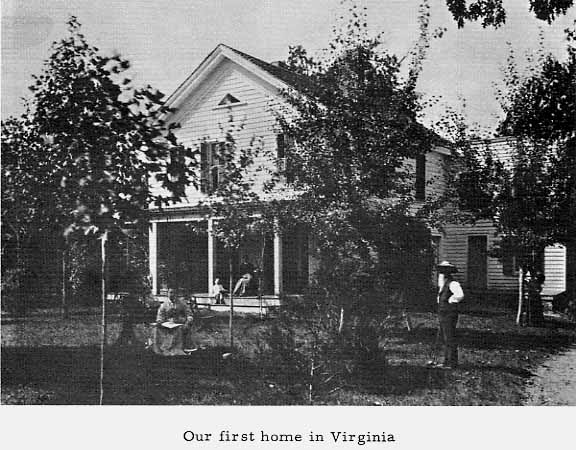
The second daughter of Mr. Vandenbergh, Charlotte, was married to a Government official, Mr. Henry Lockwood. He lived on a little farm about one mile distant from the Vandenbergh farm and rode in and out to his office every day. I often accompanied him. He was a remarkably well informed man and in comfortable circumstances. I became very intimate with him and finally told him of the conditions in which I was placed with regard to Fauth and my sister, occasioned by Mr. Wurdemann's departure for Europe. I also told him of our offer to Wurdemann and his exorbitant demands. This resulted in his offering to join our partnership and he offered to put in a couple of thousand dollars for us to begin work. We drew up no partnership papers, nor did I ever have any with Fauth, but the understanding was that Fauth was to manage the shop, I was to make all drawings and designs, in fact, conduct the business, Lockwood was to do the bookkeeping and answer such commercial letters as related to the commercial part of the business. He further agreed to put up a building for the business. This he did on a lot which he owned at the corner of B Street and 1st Street, S.W., for which he received rent. The basement and first floor was occupied by the shop; Fauth had his dwelling on the second floor and I had a room on the third. We made a mistake in this building from the very start, as it was neither a factory nor a dwelling. However, we moved in and commenced work for a display at the Centennial Exposition, which was to be held in Philadelphia in 1876. I decided to exhibit a 12 inch Theodolite containing all my improvements, including the U standards which was the first one ever built that way. Then I planned an Equatorial, which I copied largely from the Cooke model and besides, an Engineering Transit of the highest grade. I also decided to exhibit a Chronograph superior to those which had been in use at the Survey at that time. Just at this time longitude observations were to be carried on between America and Europe, by means of the electric telegraph, and accurate Chronographs were a necessity. And here again I had to thank Prof. Bauschinger for his instructions. When he once explained the action of a Watts Regulator on a Steam Engine he said, while this was good enough for the purpose, as the balls traveled only in a very small arc, yet they described the arc of a circle, when, in fact, they should describe a parabola in order to obtain regularity of action. A close proximity to a parabola could be obtained if the Regulator Arms carrying the weights were suspended, not from the center of the vertical drive shaft, but a certain distance beyond, the movement of the balls becoming, as he called it "pseudo-astatic", a name which I continued to use. When the Chronograph Regulator was to be constructed I remembered Prof. Bauschinger's remarks and constructed a regulator which has been used ever since, and the results obtained were truly remarkable, I very often would run a Chronograph sheet across the entire cylinder, which required 21/2 hours, when the second breaks would show a perfectly straight line, not differing 1/100 of a second from beginning to end. While this Regulator did excellent work on a Chronograph, where it would only have to control the increased action of gravity, it could not control the action of a clock which had to deliver power, as, for example, a Driving Clock for an Equatorial. Prof. Young solved this problem by an ingenious arrangement by means of which power is transmitted without interfering with the action of the regulator. This Regulator is used in nearly all Driving Clocks for Equatorials. But while we were busy preparing for the Exposition I continued my visits to the farm and finally my future wife, Ritie, and I were married on April 29, 1874. I then moved to the farm and drove in and out every day. If we had been fortunate enough to have autos in those days and good roads how very different my life would have been! It is true we were comfortable enough; I installed a furnace and gasoline illumination but both were failures, which, if it happened at this time and age I could rectify. But the drive in and out, especially in the winter time, was very disagreeable. Today the trip to Georgetown is made in 10 minutes, then it took one hour. With all of the discomforts, however, we were happy. We had four good children, three boys, Lee, Fred and George, and one lovely girl, called Babette, after my mother, whom, however, we lost when she was just entering womanhood, at the age of fourteen, just before Christmas 1893. I can never forget her and am often reminded of her in Lee's daughter, Louise. I can see her now pressing her dear face against the window watching for my return home at night, when she would call out to the others "Here comes the boss".
Despite the hard work I did, we did not make much material progress in the business and I often thought that if we had an article which we could turn out in large numbers in order to cheapen its manufacture, we had not to wait for customers for Astronomical or Engineering instruments. It was at that time that I invented the Solar Attachment. This instrument which I brought out in the early 80's was to take the place of the Burt Solar Compass which was then used in the survey of public lands. It had no telescope and I demonstrated at the Land Office that my Solar was more accurate and practical; it could be used even if the sun was slightly obscured by clouds, when the Burt failed entirely, and moreover, it could be attached to every Transit, and further than that it did other work which the Burt Solar could never do. Here it was that more missionary work was required, not only to visit the General Land Office in Washington, but the Land Offices in the various states. I could not leave Washington, nor could Mr. Fauth, and when I applied to Lockwood he advanced the same reason. I told him that if he could not go he should at least try to get someone in his place, and I reminded him of the fact that he had never fulfilled his part of our agreement, as he had never kept the accounts, in fact, had never started the keeping of books. This refusal on his part to help a young business made me very angry and finally led to a rupture. I told him if he did not fulfill his part of the agreement I would withdraw or pay him back his money. He finally agreed to the latter and I borrowed the money to pay him back. I am glad to say that he finally saw that I was right and we became friends again. It took me a long time to repay the money. When we parted I found a lot which would answer for shop purposes. It was located at the corner of Maryland Avenue and 2nd Street and I made the same blunder here that we had made before in building half a factory and half a dwelling place. It was many years after when I built a shop back of the house on 2nd Street. To this I added from time to time and both house and shop are still in our possession. The house was remodeled as a dwelling with every convenience.
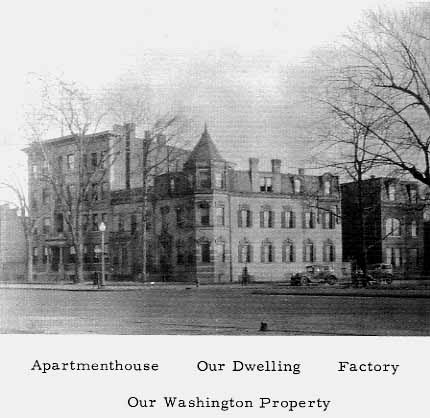
When I moved into the new shop, after we left the Lockwood house, I took my friend Marshall Wines to live with me and to do the work which Lockwood was to have done. I knew Mr. Wines from the time I came to Washington, having met him at the Bismarck Hotel, which was my first stopping place. He remained with me until I moved to Rochester, when he became manager of the Washington Office of the Bausch & Lomb Optical Company and staid with the firm until I withdrew, when he was pensioned. After returning to the farm I invited him to come and live with us, but this did not seem to appeal to him, preferring to live in Washington, and inasmuch as he is now nearly ninety years of age it is perhaps better for him to stay in town.
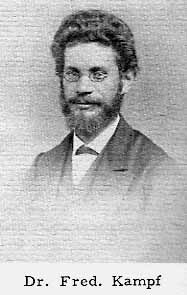
During my stay at the Coast Survey I became acquainted with Dr. Fred Kampf. He was without doubt the best Astronomer and Mathematician in Washington. Capt. Petterson, then Superintendent of the Coast Survey, required only four hours daily from him, as he did more in that length of time than others would do in two days. After a while he left the Survey and became Chief Astronomer of Capt. Wheeler, who was in charge of the Survey west of the 100th Meridian. We became very friendly and one time I asked him if he were willing to show me how to reduce time and longitude observations, which I had always taken with instruments I built and also those I sent to the field from the Survey. He answered "if you possess the necessary mathematical knowledge I will gladly show you". I then told him how far we had gone at the Polytechnic School, but thought I would probably need some brushing up, and that if he would do it I would, of course, be willing to pay. At first he did not want any remuneration, but when I insisted he said "Well, we'll call it one dollar per hour" but these hours lasted from 8 until long after 10 o'clock. It took but two or three months to get through with the methods of least squares, and he said "You do not need any more mathematics." Then I brought a portable Time and Latitude Instrument, made out the list of time and circumpolar stars and observed many hours from 8 until nearly 12 o'clock. The next night he showed me how to reduce them. As the old Troughton Zenith Telescopes were very heavy and cumbersome I asked Prof. Hilgard to allow me to put up a small observatory south of the main office building. When he asked what I wanted it for I told him that I intended to test every instrument before it was sent out to the field in order to put a stop to complaints which were caused mostly because of ignorance or poor handling of the various instruments. I then showed him a card which contained all necessary information and the constants of the instrument, such as the value of the micrometer screw, the value of one division of the level and the various magnifications of the eyepieces. Every instrument was to have such a card. This pleased Prof. Hilgard very much and he became friendlier than ever to me. I continued with Dr. Kampf for two winters and would have gone on with him, but unfortunately he was killed, having been kicked by a mule just as they were breaking up camp to return to Washington. I often think of him and shall always cherish his memory.
The Coast Survey possessed, among the many English instruments (procured by Hassler, who was backed by Jefferson) a Dividing Engine. It had a circle of 40 inch diameter, but was not automatic, and the graduating was done by hand. It was about as crude a machine as I had ever seen. I noticed that sometimes the circle turned freely, while at other times it could hardly be moved. I soon saw that it was change of temperature which caused the trouble and on taking the machine apart I found that the axis, which was a short truncated cone was a red metal casting to which steel rings were shrunk at top and bottom forming the bearings. This axis fitted into a socket of yellow brass and of course the three metals, having different degrees of expansion, made it easy to understand why the circle turned freely in warm weather and stuck when the temperature fell. I told Prof. Hilgard that the only remedy would be a new axis and bearing, both of the same metal, so that temperature changes would have no effect on its movement, but there was so much other work ahead and Prof. Hilgard had such confidence in Wurdemann's new Dividing Engine, that he always put me off by saying, "wait until we get the first of the three 20 inch Theodolites", but he allowed me to examine the circle as to the accuracy of its graduation, and as it took four observers, he assigned three aides, Fairfield, Sinclair and DeGraw to assist me. I placed a sort of housing around the engine and by means of a couple of gas flames kept the temperature quite constant and the circle moved evenly throughout the entire examination. These readings had to be reduced and it was quite a task to obtain an error for every degree. There was no one available to do the work and a circumstance occurred which should, after a while, form one of the charges with which Prof. Hilgard was accused when he was removed by President Cleveland. It happened in this way: One time I was called to Prof. Hilgard's room and there met an old gentleman who was introduced to me as Prof. Powalky, an eminent astronomer (whose Solar parallax was accepted as nearer the truth than any other). Prof. Hilgard who, at the death of Capt. Patter son, had become Superintendent, asked me if those readings of the Engine Circle had ever been reduced. I replied, of course, in the negative. "This would be the very work for you for a couple of months anyway", he said, "if I can find the money to pay you. At any rate, we will give Prof. Powalky the work and pay him $100 per month until it is completed." I then brought the circle readings up and Prof. Powalky took them home with him. While Prof. Hilgard thus showed his kindness, it was very unwise not to provide means of paying Prof. Powalky. However, it happened at the end of the month that Prof. Hilgard received a check from one of the Assistants in the Field who had completed his work and sold two horses, for which he had no further use. The check for the sale of the horses he turned over to Prof. Hilgard. This should have been turned into the Treasury, but he applied it to pay for Powalky's work. Legally, of course, he did wrong, while morally he might be excused. The work which Mr. Powalky did was very satisfactory. The maximum error found was 9 seconds of arc. I immediately went to work and designed the apparatus which was to correct the errors automatically, but before I could commence the actual work the crash came after the inauguration of President Cleveland. Supt. Hilgard and all leading assistants were suspended, including myself, on charges made by a lot of insignificant fellows, not any of whom occupied a position where he could obtain accurate knowledge. I will not go into details about this investigation, which, after all, did not amount to anything, as nobody was punished and we were all allowed to resign instead of being dismissed. At the close of this biography I will, however, attach a copy of a letter which speaks for itself. I will just mention one charge against me which was that I had stolen a clock movement. The facts in the matter were simply these: Assistant Edwin Smith was sent to Kerguelen Island to observe the Transit of Venus, I have forgotten the exact date; Captain Kater, the English Physicist, had observed the same transit 100 years before and at the request of the Royal Society he made pendulum experiments with apparatus which the Royal Society furnished. I mentioned to Prof. Hilgard how important it would be if Asst. Smith were to make the same observations with the same apparatus, which no doubt was still in existence. Prof. Hilgard agreed with me and I wrote the necessary letters to the Royal Society in London for his signature. The instruments arrived in due time, but it was a miserable outfit. The clock had a second pendulum with recoil escapement and we had to take it apart and clean it before we could make it go. I hung it in my office, opposite my desk, and tried to get its rate, which, however, was very irregular. The Kater pendulum was of the reversible type, the knife edges being 36 inches apart. After Asst. Smith was satisfied that he could work with it we packed and shipped the instruments. He returned with them at the end of the year and I again hung the clock where it had hung before, as I wanted to assure myself that it was all right before we returned it, but when we opened the box the whole case came apart and after consulting the cabinet maker we decided to make a new case. This was done and I had it packed immediately with the pendulum and sent to the store-room where instruments ready for shipment were kept. When the investigators came they asked me what I had done with that clock, pointing to the old empty case still hanging on the wall. I told them the whole story and they then inquired where the clock with its new case now was. I told them that I left it in the Butler Building, but could not say what had been done with it since I left. We went to the store-room and in a corner covered with other boxes I noticed the case. One of the investigators asked me to move it out and open it. "Do that yourself" I replied. They called a man who opened the box, which I had labeled "Royal Society Clock" and there they found the old clock in its new case. I said "Well, are you satisfied that I have not stolen the clock?" The Chief Investigator came over to me and shook hands saying "I do not think that we shall want you any more". Thus my services at the Coast Survey came to an end, but I had no occasion to be ashamed of my record. The instruments were in far better condition than they had been when I assumed charge. Although I had not time to make the dividing engine automatic, I regraduated an old 14 inch Theodolite by hand, using Pawalski's corrections. An examination of the graduation proved that the greatest error found was only 2 seconds; much better than Wurdemann's 20 inch circles, which had, in the meantime, been received. I was ordered to regraduate one to see how much better my graduation would be and it proved conclusively that my graduations were three times more exact than Wurdemann's. Later on I regraduated the other two.
There is another matter to which I devoted a great deal of my time and which has been entirely misrepresented by Col. Lester Jones the late Superintendent of the Coast Survey, who gives Mr. E. Fischer the entire credit of building this machine. I refer to the Tide-predicting Machine. The real inventor of this machine is Prof. Ferrel, who for years had talked with me about his ideas in regard to building such a machine and we discussed many plans long before Mr. Fischer ever became acquainted with Prof. Ferrel. While Prof. Ferrel was a good mathematician, he was no mechanic or draftsman, and the designing of the gears for the various components bothered him a great deal. These components, about two dozen, consist of 4 gears which turn a shaft, to which an adjustable eccentric is fitted that carries a small pulley. All these components are connected by a wire which passes over the pulleys, and the amount of rotation of these pulleys in relation to each other, had to be correct within the third or fourth decimal I believe. To obtain the correct amount of motion with these 4 wheels would have been very easy had their size been of no consequence, but the largest diameter Prof. Ferrel would allow, in order not to make the machine too large, was about 2 inches, and it required a great deal of patience to hit on the diameter and pitch of these wheels to obtain the desired result. This I did to the perfect satisfaction of Prof. Ferrel, but any able mechanician could have done the same and I never claimed any great credit for this work. When we had the correct dimensions of these various components, Prof. Ferrel explained the matter to Prof. Hilgard, who ordered me to have proper working drawings made. At that time Mr. Fischer was in the employ of Fauth & Company and I knew of no better man to entrust that work to. He not only made the working drawings, but after Fauth & Company obtained the order to build the machine, also did most of that part of the machine which carried the components and which we called the motion work. The other part of the machine, which we called the transmitter, conveyed the motion through the sine and cosine frame to the dial, and this was not even begun when Mr. Fischer left the employ of Fauth & Company to accept a position in Hoboken, N. J., I believe. Under the direction of Prof. Ferrel, I made the drawings for that part of the machine and the work was done and the machine entirely completed by Camill Fauth and Otto Schilling. When the machine was delivered to the Coast Survey, all the working drawings were also handed over, and no doubt they are still in existence. Anyone can distinguish Mr. Fischer's drawings from mine, and years ago, before the second machine was built, Mr. Andrew Braid told me that my drawings were marked by my initials. I believe Mr. Braid looked into these drawings, as Mr. Fischer then claimed to have designed the entire machine, and Mr. Braid knew that this was not the fact. I did not take any interest in the controversy - although I was called upon - as I was busily engaged otherwise and did not deem the matter of great importance to me. I feel the same way now, but think it is a shame to rob a dead man of his laurels. I repeat that Prof. William Ferrel was the inventor of the Coast Survey Tide Predicting Machine. Any able mechanician could have built the machine, without either the assistance of Mr. Fischer or myself, under Prof. Ferrel's directions. That Mr. Fischer built a larger machine, which no doubt is an improvement over the first one, I fully believe, as I consider Mr. Fischer an able mechanician, but it is a comparatively easy matter to build a new machine when you have a model and recommendations as to changes from the parties who worked on the first machine.
I could mention a number of improvements and inventions which I made while at the Survey, a new Reversing Pendulum, an improved and simple Base Apparatus, an Automatic Level Grinding Machine, which ground levels on any radius with the greatest accuracy, but it would take too much space and could not be very well understood without drawings.
After leaving the Coast Survey, I devoted my entire time to the business of Fauth & Company, and strange to say among some of the first orders I received was one from the Survey for three Theodolites. At the request of some of my friends at the Geological Survey, who had heard of my accurate graduations, I designed an instrument which was to replace their 10 inch Theodolites which they used for secondary triangulations. These instruments were read by verniers to 5 seconds, and in order to obtain closer results they had to employ the method of repetition, which, of course, is a very laborious process. I designed a Theodolite with a circle of 8 inches diameter, not intended for repetition, but so arranged that the circle could be moved in order to bring different parts of the graduation under the microscope. I had dispensed with verniers but employed two microscopes which had a field large enough to show the degree numbers. I graduated them with a diamond giving a beautiful line. I should have mentioned that Fauth & Company had commenced the building of a Dividing Engine which I finished as soon as I left the Survey. The first two of these Theodolites were very carefully examined by the officers of the Geological Survey and were sent out to the Field. They gave such excellent results that I received orders for quite a number. The graduations were found to be so perfect that the circles were never shifted. The Coast Survey officials heard of these instruments and gave me an order for three. In the meantime the conspirators and informers had all been removed and I was friendly with the whole personnel. I never solicited orders nor bid on any proposal without stating my catalogue prices, which were higher than those of any of my competitors, but at the end of every fiscal year (end of June) if the various Bureaus had any money left over which they did not want to turn back into the Treasury they would purchase instruments. I knew pretty well beforehand what their demands would be and generally had quite a number on hand, ready for immediate delivery. This was important as their proposals called for it; so I filled out the proposal with my standard price, guaranteed delivery immediately, ready for the field , and invariably got the orders.
I also did some work for the Naval Observatory. At that time there raged quite a fight between the Navy and the Civilian Professors as to who should really have management of the Observatory, Finally a compromise was reached in that the Superintendent should be a Naval Officer, but that the various instruments, such as the large Equatorial, the Transit Instrument with its time service, the Prime Vertical and the large Meridian Circle, should be under the charge of the Civilian Professors, assisted by young Naval Officers assigned for that purpose. These young officers get very little help from the professors and I was often called upon by them to put their instruments in order. And here it was that my studies with Prof. Kampf brought their reward. At that time Lieut. Sampson was in charge of the Transit instrument and virtually of the Time Service. Many a time the professor in charge returned the time observations back as worthless and relied on the rates of the clocks. In his trouble Lieut. Sampson called on me and I was very glad to be of assistance to him. I put the instrument in order and for months would go to the Observatory every night, and very often I had to walk from there, not only to reach the "M" street cars, but had to walk all the way to my home on Maryland Avenue. I not only showed Lieut. Sampson how to put the instrument in order for observation, but reduced the results by means of least squares, but this laborious work brought its compensation in later years.
After leaving the Survey I moved into the city and remodeled the house at Maryland Avenue and Second Street and made it quite a comfortable dwelling. While we were living on the Farm I employed a governess, whose services, for reasons of economy, I dispensed with, and the children attended the Public Schools in Washington. I had more time for my business correspondence which I generally carried on in the evening. We got along fairly well and gradually paid off our debt which was incurred by buying the land and putting up the buildings. However, neither my sister nor Mr. Fauth could endure the climate and both wished to return to Germany. This came to pass when Mr. Fauth's father died and when his presence in Germany was desirable. So they departed - I do not remember the exact date - and I promised to pay them $50 per month, all I could spare out of the business, and it was often very embarrassing to spare this sum. I had the entire burden to bear and had just embarked on the manufacture of large instruments. Among others, I built the Cincinnati Meridian Circle, which to this day is used without regard to any correction for graduation errors, as it is practically faultless and has taken an enviable part in the international determination of the declination of stars 20° adjacent to the Equator. I also built a large number of Equatorials, among which was the 20 inch for Denver, and another of like size for Manila. Prof. Howe often declared that the Denver Equatorial was the finest in this Country. It contains all the latest improvements. Financially, the building of this Equatorial was not a success. I took my pay mostly in lots on which I paid taxes for years. Most of these lots were located in sections of Denver which did not improve and the best ones Mr. Wines forgot to pay the taxes on, so that many thousand dollars were lost in this way.
The first Equatorial, which contains my star dials, was built for Georgetown College. This arrangement consists of a Declination and Hour Circle situated directly above the handwheels by means of which the Telescope is moved in declination and right ascension, which movements are indicated on those star dials. In large instruments, where the circles are high above the floor, they either have to be read by means of long reading telescopes, or by climbing a ladder to read them. In my improvement the motions of both axes are carried down to a convenient height and terminate in a pair of wheels, one moving the Declination axis, the other the Hour axis. Both moved circles and the Hour circle carried another one moved by a clock set to R. A. time. The difficulty arising from the Declination circle moving when turning the R. A. axis, is overcome by means of epicycles. This arrangement is very convenient and has been adopted by all makers of large telescopes. It should have been patented by me.
Sometime in the late 80's I was called to the Ordnance Office of the Navy Department. There I found as Chief of Ordnance my old friend Lieut. Sampson, whom I had instructed in his time observations at the Naval Observatory. He had risen to the rank of Captain, but as Chief of Ordnance ranked as Admiral. He was very glad to see me and said "perhaps I can pay you now for the great kindness you showed me at the Observatory", and then he told me that he had a letter from Capt. Fiske, stationed then in the far East, in which he told him that he had obtained excellent results by using a telescope for sighting guns; that he used an ordinary Draw Telescope which no doubt could be improved upon and also a suitable mounting provided. When Admiral Sampson explained that a very large field was desired and a low magnification I told him that I could make him such a telescope. This I did and the Admiral gave me an order for 100 at a very fair price. He also told me that these 100 telescopes would be distributed among the vessels of the fleet; if the reports on their performance were favorable a great many more would be ordered. This, of course, was welcome news to me and I hastened to experiment on telescopes until I thought I had one which would please the Admiral. It did, and I forthwith commenced to lay out the mechanical part. As for the optics, I made up my mind to get these from Nitsche & Guenther, Rathenow, who had supplied me with eyepiece lenses at a very reasonable figure. I had started a small optical department with Mr. Clacey at the head, but he was only of use to me for objectives, which he turned out in great excellence. He was exceptionally successful in large apertures with short focus. Among the larger lenses he made for me was the 8 inch for the Catholic University and the 12 inch for Georgetown, but for mass production of small lenses, such as are used for eyepieces he was of no use, and he finally moved out into the country where he worked for me until I left Washington.
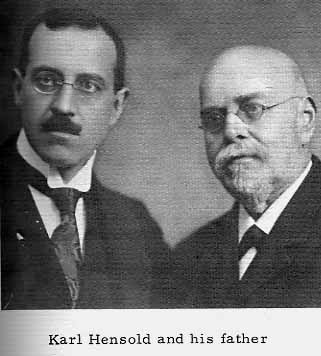
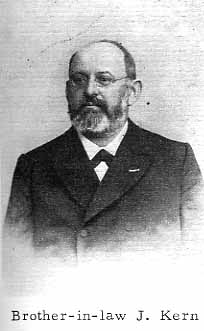
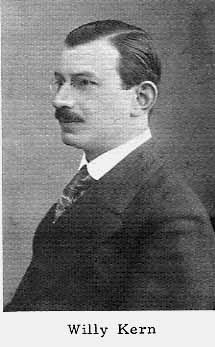
The procuring of optics led me to go to Europe and there was also another reason for my going, i.e. - to settle the relations between Mr. Fauth and myself. He had now been away for three or four years and I had sent him $50 a month. He had regained his health and as he had inherited some property from his father he was rather pleasantly situated and occupied his time chiefly in hunting and photographing. I came speedily to terms with him and he accepted $10, 000 for his share of the business, which I was not to pay until I was able to do so, but it was arranged that I would send him $50 each month, being 6% of the principal. He lived in Ansbach, not far from Nuremberg, and I made haste to get there, as I had written my friend Eckstein from Berlin that I would be in Nuremberg very soon and that I would telegraph my arrival a few days ahead. This was in the fall of 1889, nineteen years after I had left Nuremberg. Eckstein had called out all the "Einjaehrigen" and all were there with the exception of three, who lived too far away. We met in the "Gruene Baum" and stayed together until early in the morning. They told me of the war (1870) and of the death of several comrades in battle. I prolonged my stay one day with Eckstein and then went to see my mother who then lived in the nearby city of Schwabach, where she moved after my father's death, which occurred a year after I left for England. He had attended a Teachers' Congress in Munich, contracted typhoid and came home only to die. Besides my brother John and my sister Barbara I had two other sisters, Emma and Sabine. Emma had married George Hensold, Professor at the College in Schwabach, and Sabine was married to Johannes Kern, who occupied a very responsible position as Inspector of Schools for the whole of Franconia. He had his headquarters in Schwabach and my mother moved there to be near her daughters. Johannes Kern died very suddenly a few years before my visit to Germany and George Hensold passed away only last year. Each left a son; one is my nephew, Prof. Karl Hensold, now in Augsburg, the other, Dr. Willy Kern, a chemist employed in a Color Factory near Frankfurt. On my return home I stopped for about two days in Frankfurt to see my cousins and my brother John, who, after he had spent some time in Switzerland, France and England, had become manager of my Uncle's hotel "Englischer Hof", the largest in Frankfurt. He talked with me about retiring from business and I told him that he was too young to do such a thing and that he could easily work another five or ten years, as he was then but 60 years of age. I asked him about his circumstances but he never would tell me and I left him in rather a disgusted frame of mind. My uncle died soon after this and he really retired and purchased a Villa on Lake Sternberg, near Munich, and made other foolish investments. I never heard from him except when he wanted something. At the time of the inflation he sold his Villa for several Billions and was a rich man for several weeks, when he had to give up his home and rent another, as the value of the Mark dropped very rapidly. Previous to that, when times became hard in Germany, I bought him an annuity, but in the crash this went down to almost nothing. After he had lost everything I agreed to pay him $50 per month, and this I am now doing and shall continue to do.
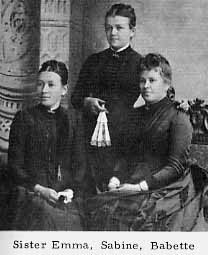
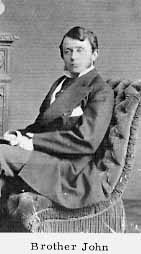
Well, I arrived back in Washington and took hold of the business. Several years before I had engaged a foreman, Mr. G. Fecker, from Germany. He was a very competent man and the only fault I had to find with him was that he would never stick to one model, even though he had found out that it was entirely satisfactory. He would keep on changing and for this reason I never allowed him to have anything to do with Navy work.
My chief competitors in the Astronomical field were Warner & Swasey, and as Warner was a very close friend to J. Rockefeller (he was only five years younger) and as Rockefeller was generally the one who furnished the money to colleges, it is easy to see that I had very little chance against Warner & Swasey, although sometimes I did beat them on the superiority of my designs. About this time the Naval Observatory wanted a new Meridian Circle and the Warner & Swasey Company underbid me by just $10. I became suspicious and watched Fecker closely and ascertained that he was busy late at night copying drawings and making blue prints (he lived in one of my houses, next door to mine). I do not recall what it was that brought on an excited word battle, with the result that he gave me a month's notice of his intention to leave. I said "No sir, you leave this very day, but not before you have brought back to me my drawings and anything else belonging to me". This remark staggered him and I could see that it was up to me to retain him if I wanted to do so, but I never took any notice of him and informed the men that Fecker was no longer foreman. From the time that Warner & Swasey had received the contract for the Meridian Circle for the Naval Observatory they had made no progress in the design. I was not surprised to hear that Fecker was with them and he copied my designs, not only for the Meridian Circle, but also all of my astronomical instruments, which is evidenced by the fact that the illustrations in my catalogue, which appeared years before Warner & Swasey went into the building of Transits and Zenith Telescopes, show that they copied my instruments in nearly every detail. It took about three years before that Circle was delivered.
Meanwhile, I kept on making Telescopes for the Navy in large numbers. Gradually they found out that a very large field was not required, but a higher power. I convinced Admiral Sampson that a high power telescope mounted on a gun was of no use until it could be adjusted to be parallel with the gun by a Boresight, which is a telescope placed exactly in the axis of the gun. I constructed one to the entire satisfaction of the Navy and Boresights are still in use in the Navy and we have made a great number of them. The next thing the Admiral wanted was that all Gun sights should be interchangeable, so if one telescope is taken out and another one put in its place it must point to the same mark placed at a great distance. As the bodies of all telescopes were made out of tubes and round, this interchange could not be very well accomplished, until I hit on the idea of making the telescope bearings of the hexagonal form, and to this end we constructed a collimator, firmly fixed to the Milling Machine, which gave an infinite pointing mark. The Telescope completed, with the exception of of [sic] these bearings, was then placed in position, pointed to the collimator cross wires and a slight cut taken from the bearings. This device worked beautifully and all telescopes pointed the same.
After Mr. Fecker left me and my son Lee came home from Europe, where I had sent him to learn the practical part of the business with the eminent mechanician, Mr. Tesdorpf in Stuttgart, Lee and Albert Grebe, who worked at Mr. Tesdorpf's and came to America with Lee, worked together in my shop. In fact, Grebe followed me to Rochester when I moved there and stayed there as foreman until he went to Los Angeles, where I understand he is at the present time and doing very well in a film factory.
I continued to prosper and added one piece of real estate after another until I finally owned nearly the entire half block of the square which faces the Capitol Park on the East and the Botanical Garden on the North. This land has since been taken by the Government and condemnation proceedings are now before the Court.
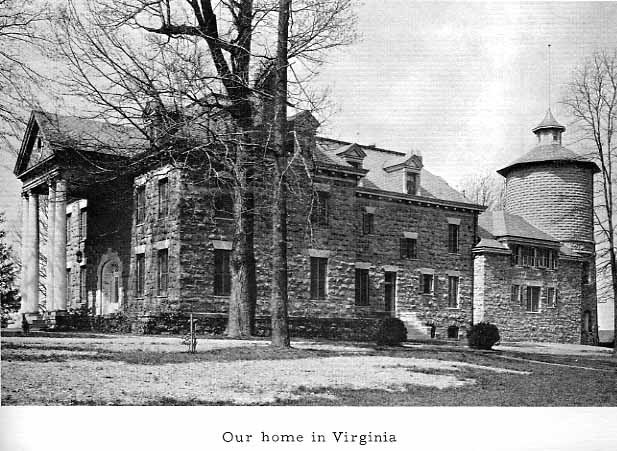
I added also considerably to the Farm which I purchased from my wife's father. It originally contained 150 acres and I bought land adjoining so it now comprises 243 acres, in addition to the 30 acres across the county road. This farm has always been a millstone around my neck and I would have done better had I given it away when I went to Rochester and invested the money which I was obliged to send there every month for its upkeep. I tried in every way to make it self sustaining, dairy, chickens, hogs, but without success. The trouble was that the foreman I had, Mr. Henry Chapman, although an honest, diligent and hard working man, had absolutely no talent or ability as an overseer. However, he had been with me for such a long time, about 46 years, that I was reluctant to part with him, and he remained with me until he, of his own volition, retired about two years ago, and he is now living with his daughter. He visits me occasionally, never forgetting to bring a bunch of mint into the house. I also had an old hanger-on, Aleck, who was with me for 55 years, in fact, until he passed away, last Christmas. Owing to Washington's rapid growth, the farm has become very valuable and it will not be long before it will be laid out into building lots.
Time rolled on. We spent the summers on the Farm and the winters in Washington. Lee had come home from Europe, Fred had graduated from the University of Virginia and was now at the Massachusetts Institute of Technology in Boston, and George had just entered the Washington University. One day, in the fall of 1903, Mr. Edward Bausch came to see me and we arranged that he should spend the day following - Sunday - at the Farm. We walked all over it and finally talked about business matters and I told him what difficulties I had in procuring the necessary supplies in Washington and how hard it was to keep men, for as soon as they were well broken in they sought positions under the Government. The Navy Yard, Coast Survey, Geological Survey were all glad to get trained men, and inasmuch as in Government shops they worked only 8 hours, as against my 9 hours, and the further fact that in the employ of the Government they were given a month's leave of absence with pay and another month for sick leave, it is quite plain that they were willing to leave me, and enter Government service. Edward Bausch mentioned that conditions were certainly better in Rochester and as none of the Bausch's had any boys - with the exception of Mr. William Drescher, who had one son, then only 10 or 12 years of age - there would be quite a field for my three sons. I did not want to do anything without their consent and arranged that Fred should come home for Thanksgiving, and that all three, along with Mr. Wines, should go to Rochester to look the situation over. All agreed that it would be best to move there and form a companion firm "Bausch-Lomb-Saegmuller". On a subsequent visit of Mr. Edward Bausch we agreed to this, although we did not draw up any legal papers. I stipulated that I would move my shop as soon as I had completed a large order for the Navy Department. Moreover, I had been appointed a judge for the St. Louis Exposition, which would keep me away at least two months.
Before the St. Louis Exposition opened, Dr. Czapski, one of the leading men of Zeiss, came to see me, and said that he would like to show the Navy Department some of their Gunsights. I offered to introduce him to Admiral Sampson, but he replied that the German Ambassador would do that. A day later he came again with a case of the Zeiss Gunsights. He said they all laughed at him and told him that they were satisfied with Saegmuller, in fact, he said "you are too firm in the saddle and we will give up any effort to get orders from the U.S. Navy Department" and then he surprised me with the proposition to found a firm with Zeiss and myself, I to remain in Washington. I told him that had he come a year earlier that proposition would have been very alluring but that I had agreed to move to Rochester and join the Bausch & Lomb Optical Company. "This is too bad", he said, "but is the agreement legally binding?" I told him "No", that no papers had been signed, but that I would not go back on my word. He again said that it was too bad, adding that they were not at all satisfied with Bausch & Lomb; that they had given them the right to make the Zeiss Binoculars and Anastigmats, but that so few were being sold and that they didn't come up to the Zeiss standard. However, he said that he hoped my coming up to Rochester might change the situation for the better.
He also told me that when talking at the Navy Department about Range Finders, in which they had taken great interest, they asked who, in his opinion, could make them in this Country, and that he told them that Saegmuller could make them but not Bausch & Lomb. Dr. Czapski left his box with gunsight samples with me and told me to hold them until he called for them. They were all fine instruments but very small in size and the Navy Officers said "what we have suits us better".
It is a curious fact that while I received more and more orders for Gunsights I raised my prices for Transits thinking that I would not get the orders. However, such was not the case, and I left quite a number of orders with Mr. Schilling - who was to remain in Washington to look after any pressing repairs for the Navy - for whom I fitted up a shop in 13th Street. I sent a great many parts for new Transits to him from Rochester. He worked for me until his death which occurred a few years later. We did not finish the many Navy orders which were most pressing until in the spring of 1905 when I moved my entire shop to Rochester.
When Mr. Edward Bausch and I agreed about my coming up to Rochester I stipulated that we should have a Scientific Department, and as Dr. Czapski had spoken very well of Dr. H. Kellner, whom he had visited in Buffalo where Dr. Kellner was employed by the Spencer Optical Company, I told Mr. Bausch about him, urging that we employ him, but the decision was delayed and the matter was not taken up until about an hour before the time when Dr. Czapski sailed for home. Both Edward Bausch and myself saw the Doctor off on the SS "Moltke" which sailed the day after the presidential election. Then Mr. Bausch asked Dr. Czapski if, in his opinion, Dr. Kellner would be the best man for the company, and he replied "I do not know whether he would be the best man or not, but I do know that he showed me some very good work which he did at the Spencer Company". I should mention that Dr. Czapski was acquainted with Dr. Kellner; he brought him to Jena and gave him employment at Zeiss's (at 100 Marks per month) so that he could study at the University and take his doctor's degree. I went to Rochester with Edward Bausch and Dr. Kellner was sent for and was engaged by Bausch & Lomb. As I stated before, Fred was at the Massachusetts Institute of Technology, where I sent him at the advice of Admiral Taylor, who was Chief of Construction and Repairs, and who promised a position for him. However, when it was decided that we would move to Rochester, I thought it would be a good plan for Fred to leave Boston and take an optical course with Dr. Kellner, where I think he went early in January, 1904, and staid six or eight months before coming to Rochester. I paid Dr. Kellner $100 a month for his instructions.
When I left Washington my relations with the Navy Department were on a firm footing and I took with me to Rochester orders for Gunsights amounting to $70,000 or $75,000. When I developed the Boresight and the interchangeable telescopes - by means of hexagonal bearings - I took patents out for these inventions. When Admiral Sampson heard of this he called me to his office and told me not to take out any more patents as the Navy wanted to keep their whole fire control instruments secret from other Navies, whereas a patent gives everything away. He said "Keep on and make for us the best instruments you can at a fair price, on which we will agree, and we give you the orders without other bids being asked for". He made known this proposition when he was assigned to take command of the battleship "Iowa", to Capt. O'Neil, who succeeded him as Chief of Ordnance, who in turn informed his successor, Admiral Mason, and all carried out the agreement until better telescopes were offered, about which I will relate later on. Some four or five months before Admiral Sampson left the office he asked me to make for him a Range Finder for the "Iowa". I told him I would try my best but I had no experience and the time was rather short, as he wanted it within four months. He wanted a Range Finder of the vertical type as it would take up less room. I went to Clark and asked him to make for me a couple of large double reflecting prisms, which he did, but informed me that the glass he used was not the best for the purpose and the reflecting surfaces had to be silvered, as sea water would attack the glass. The front surface was, of course, not silvered, but could be kept clean. I made the Range Finder, which was suspended in a high U standard, revolvable on a base, with the eyepiece in the middle, just about the height of a man of medium size. It had a base of 10 feet. When it was completed I took it, at the invitation of Admiral Sampson, who was then on the "Iowa", to Yorktown. He asked me to take a distance of a lighthouse, as it was dark when I finished setting up the Range Finder, and I measured it to be 8900 yards. By the map the Admiral told me the distance was 9000 yards, but that he was satisfied. The next day various officers took distances with pretty good results. The coincidence of the two images was made by the tilting of a plane parallel glass and the amount of tilting was read off on a scale graduated to yards. This arrangement was due to Father Searle, who aided me as much as possible in the construction of the instrument. But the silvering of the back surfaces did not last long and the glass showed the action of the sea water. The prisms were returned to me to be re-polished and silvered several times but stood the test for only 3 or 4 months. Admiral Sampson wrote me a letter praising my efforts and advised me to keep on trying to develop an instrument where the optics would withstand the sea water. Although I had no formal order he requested Admiral O'Neil to pay me $2500 for the instrument. On the "Iowa" he treated me as an honored guest and gave me the room kept for an Admiral. These were the last proofs of kindness shown me by Admiral Sampson. The war with Spain broke out and unfortunately Admiral Sampson went out to sea on the day the Spanish Admiral Cervora tried to make his escape and when he arrived Admiral Schley was already in action and afterward claimed the victory, which resulted in an inquiry. This grieved the good Admiral and he died soon thereafter.
Before closing my activities in Washington I wish to add that I took great interest in the affairs of the County. [See Appendix I, Falls Church Monitor, November 19, 1898.] I was elected Supervisor for Washington District and became Chairman of the Board. During my incumbency I built the Courthouse and Jail, and although we had but $20, 000 to expend for this purpose, the buildings were finished within the appropriation and are a credit to the County. But the greatest credit I claim is that I brought order in the finances of the County. Before my time County warrants were not worth their face value. Any one who had done work for the County or had furnished supplies had to sell his warrants or wait for months until the Treasurer had money to redeem them. I called upon the Treasurer, Mr. W. Wibirt, and asked him how much money would be needed to pay all warrants as soon as they were issued. He said it would take about $10,000. I went to the National Bank of Alexandria with him and on my personal note he received the money. This restored the credit of the County and lowered all prices for supplies. Of course, I got my money back. I had the satisfaction of breaking up a ring which had made money out of buying County warrants at 80 cents on the dollar. I also advanced the money to build a school house at Walker's Chapel to save the children who lived there from a long walk to Carne School. Then I started the fight for good roads and advocated bonding the County. I explained to the people the waste of money in the existing system; showed them that with no increase in taxes we could build the roads, provide for their maintenance and establish a sinking fund for the redemption of the bonds, but in this effort I was defeated and I dropped County matters.
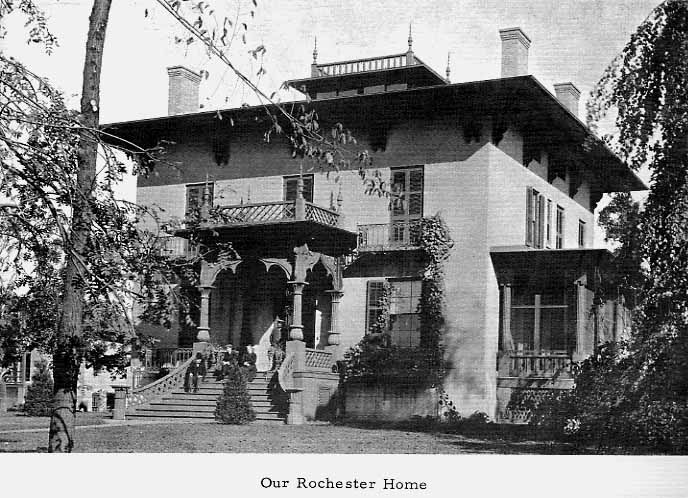
In the spring of 1905 we went to Rochester and I was very much disappointed at the condition of things. That they were far behind in mechanical equipment I knew before I came, as I had gone through the Works on my frequent visits to Rochester, having placed large orders for the cheaper lenses for eyepieces which I had formerly imported from Rathenow. As far as higher grade optics was concerned they could not compete with Steinheil, from whom I imported the lenses for my higher class instruments. Of course, we had a Scientific Department, but immediate results could not be expected. I had brought large orders for Gunsights with me, which were added to later on. I had a long talk with Dr. Kellner impressing upon him the fact that we must keep our Gunsight Telescopes up to the standard and that he must improve on them, if at all possible, as I knew the Bureau was besieged by other makers offering cheaper and, as they claimed, better telescopes, but Dr. Kellner was too much absorbed in his wife's musical career and did nothing toward improving our telescopes. A message from the Naval Inspector, stationed at the Works, which he had received from Admiral Mason, successor to Admiral O'Neil, brought me to Washington. He told me that he kept the arrangement arrived at by Admiral Sampson and followed by Admiral O'Neil until Keuffel & Esser had submitted a Gunsight Telescope which they regarded as comparable to one of mine and which they wanted tested. This request could not be denied, moreover as it was backed by political influence. As the report of the Bureau of Standards was favorable to Keuffel & Esser the Admiral said "After this I shall have to advertise and you must take your chance of getting orders, quality and price of course will be decisive, but - he added with a wink - if you improve your telescopes at least to be even with the best submitted, the time of delivery will play a great role in the awarding of contracts". As I had the patent on the hexagonical bearing, which permitted the exchange of telescopes and on which the Navy insisted, my competitors soon stopped bidding, especially since I had obtained my competitor's sample and improved on it, I had very little competition in the future in this direction. Besides, Lieutenant Mustin had constructed a telescope which he patented and which was adopted and on which I offered him a generous royalty and we were practically the only bidders. This telescope is known as the prismatic telescope, having prisms at both ends and being mounted vertically on account of the limited space in the turrets. So the military situation was again saved and to this day Bausch & Lomb receive large orders from the Navy for Telescopes and Range Finders of large size.
Before we began the manufacture of Engineering Instruments (Mr. Schilling in Washington could not fill all the orders, in spite of being furnished with such parts as we could turn out; I had two very good customers for years, the Lehigh Valley Coal Company and the Calumet & Hecla Copper Company, and these I did not want to lose) we had a conference and Edward Bausch remarked that as these instruments were turned out by an optical firm they should be distinguished by improved optics. To this I agreed and we called Dr. Kellner and asked him if he could improve the optical properties of telescopes for engineering instruments without increasing their focal length, as this would have added to the height of the standards. He promised to take this matter in hand at once and in a short time produced a lens which was considerably larger in diameter and of course gave much more light to the image. Both Edward Bausch and I saw the great difference and as we wanted to construct engineering instruments on a large scale to cheapen cost of construction, we ordered 100 Transits to be taken in hand with these large objectives. There I made a great mistake; we should have made only one instrument and tried that out thoroughly, for we found that the new objective was much heavier than those ordinarily used in Surveying Instruments (on account of its larger diameter and thickness and its increased mounting), but it had also to be counterpoised at the eye end. This was a very serious objection, but the worst came when we examined a finished instrument. The sample instrument only carried a single set of crosshairs, but when we added stadia lines (for measuring distances) we found them so curved that they were entirely useless for the purpose. Dr. Kellner tried everything but without success and in the meantime the 100 instruments with the large objectives were about finished. We were able to get rid of some that were ordered without stadia wires, but on those with stadias we had to cut the aperture down until we obtained a fairly flat field. This was a very disastrous beginning for the Engineering Department, in fact, killed it from the very start.
Another mistake was made when I put Dunbar Scott in charge of the Engineering Department. He was a Mining Engineer out west and ordered several instruments from me while still in business in Washington. From his letters I could see that he was an intelligent engineer and he certainly was a master of the English language. When he heard of my combining with Bausch &c Lomb he applied for the position as head of the Engineering Department, knowing that I was busily engaged with military matters. We engaged him and I instructed him as to his duties. He was to have charge of the correspondence, test the instruments before shipment, and whenever he had any spare time was to prepare a new catalogue. I gave him one of my old catalogues and indicated how the new one should be changed so as to describe our new instruments. As I was very busy at the time with Range Finders for the Navy I could not devote much time to overseeing his work, but when he had nearly finished the catalogue and had already given parts of it to the printer I noticed that he had written a complete history of engineering instruments, which was not at all what we wanted, but inasmuch as nearly two-thirds had been printed we allowed him to finish it and it was published under the name of "Metro".
Another thing he did which cost us a great deal of money; he would take orders for instruments which did not conform to our standard instruments. We finished them in series of twenty with the horizontal circle graduated into third degrees reading by vernier to 30 seconds. Sometimes a customer wanted the circle graduated into quarter degrees reading by vernier to 15 seconds. Instead of waiting for the next series which came to the finishing room ungraduated and could easily be graduated to 1/4 instead of 1/3 degree, he would take a finished instrument, have the graduation removed and then have it regraduated. This entailed a cost of more than $25 and was entirely unnecessary as the customer could have waited a few weeks longer or taken a standard instrument. I stopped him from doing that but he would relapse into his pernicious habit whenever he saw that he was unobserved.
At that time the Navy had but very few Range Finders, mostly Barr & Stroud instruments about 4 ft base. Mechanically they were well constructed, but the optics were very poor. At that time Zeiss made stereoscopic Range Finders, which, however, were then not generally liked, as some observers could not see stereoscopically. It was only in later years when these instruments gained favor. In 1908 a delegation from Zeiss came over to try and form a combination with Bausch & Lomb, Prof. Straubel, Dr. Bauersfeld (I believe) and Dr. Paul Fischer, their syndicus, or lawyer. The combination was formed and there existed than (formerly they had acquired an interest in Bausch, Lomb, Saegmuller by paying a rather high price) Bausch, Lomb-Zeiss, and Bausch, Lomb, Saegmuller, Zeiss. It was proposed that a new combination should be formed, combining these two firms into one under the name of Bausch & Lomb Optical Company. I thus became a member of the Bausch & Lomb Optical Company. I cannot recall now what I had to pay for the Bausch & Lomb stock, but I know that after war had been declared between Germany and the Allies, before America entered the war, Zeiss declared their withdrawal on the ground that we had furnished military instruments to the enemies of Germany, and as the agreement between us described the method of how the value of the stock should be computed, they received for their stock, I believe 4 Million Marks, and their stock thus returned was divided among the various members of Bausch & Lomb and I finally became the owner of 6040 shares. Of these I gave 500 shares each to my wife and three sons, leaving me with 4040 shares, which I kept until my final withdrawal in 1926.
When the Zeiss delegation came over in 1908 they brought with them a Coincidence Range Finder of 9 or 10 ft length. It was a beautiful instrument with excellent optics, but mechanically not equal to the sturdy construction of Barr-Stroud. In fact, it was made more like a microscope. But we ordered the optics for a number of Range Finders from Zeiss and gave the instruments a more solid construction. We soon increased the dimensions of these instruments from 10 to 30 feet, as they were to be mounted in the turrets. At first I adopted the plan of stringing wires into the tubes, on to which the optical parts were attached. These wires were under high tension, and while they did not, as I expected, keep the optics in line, yet they gave the instruments great stiffness. However, when the Range Finders became longer and longer these wires were discarded and the optical parts mounted in the tubes. In the meantime, Zeiss had invented an adjusting apparatus, which was built into the tube and by means of which the Range Finder could, at any time, be set to exact infinity. This was a great advantage over Barr-Stroud and Bausch & Lomb are building these instruments to this day.
Just before the outbreak of the war I went to Jena. There I noticed a small Range Finder intended for Infantry. Only two of these instruments were in existence; one was in Berlin; the other, the one I saw in Jena. They were called the "Schuetze" type and were so constructed that the inner tube carried two objectives of slightly different focal length, thus forming, in the eyepiece, two images of an observed object, which could be brought into coincidence by turning the instrument slightly in azimuth. The distance was read on a scale in the field and where the two images coincided the figures under this point gave the distance. For infantry use no better instrument could be devised, as it required no adjustment and could not get out of order. I kept this instrument with others which I brought home with me. Among them was a Range Finder of 1 1/2 meter length, intended for torpedo boats and destroyers, as I knew the Navy were in need of such instruments. I submitted this instrument to the Naval Inspector at the factory, who approved it, and it was then sent to the Washington Navy Yard and given a thorough trial. This resulted so favorably that I received a large contract amounting to over $2,000,000. Now, instead of copying the instrument exactly as the sample, Dr. Kellner proposed certain changes, as he said the eyepiece prism (which united the two images) was too difficult to make, but that he could make a simpler one and equally effective. The Zeiss eyepiece was placed obliquely on the tube, making an angle with the vertical of 45 degrees. This gave the observer a very comfortable position. Dr. Kellner constructed a prism with the eyepiece on top of the instrument. This required the observer's bending over it and looking down vertically. When a. sample of this construction was submitted it was soon returned as entirely unsuitable, as the observer's eye was apt to be hit when, while observing, the ship made a sudden lurch. Dr. Kellner tried for more than two years to devise a suitable prism and when the Armistice came the order was withdrawn and we lost this chance of keeping the shop busy and making good money besides. And still we could have kept this order if Mr. Drescher had not interfered. During the war we were ordered to guard the factory and we had quite a bill against the Government for that service. I proposed to the Chief of Ordnance that if he would not cancel that order for those 1 1/2 meter Range Finders we would withdraw our bill for guarding the plant. The Chief was willing as the instruments would be needed sooner or later, but when I told Mr. Drescher about it he said "We had better let the matter go as it is now in the hands of the lawyers". The result was that we lost this highly profitable order and never received one cent for the guarding of the plant.
I had never solicited any work from the War Department, as Warner & Swasey did their work. So long as they left me alone with the Navy I did not bother them, but during the war the War Department came to us and we received large orders for Range Finders and Observing Telescopes. So, with orders from the War and Navy Departments and those for foreign governments we were exceedingly busy and were required to put up new buildings. We purchased one-half of the square across St. Paul Street and put up Building No. 14. This, to me, was a very poorly designed building. It was originally intended for four stories and I remarked to the architect (Firestone) that I thought the light shafts were entirely too small and that the building would be too dark. My criticisms were not heeded; on the contrary, two other stories were added, and as a result this building needs artificial light from morning until night. Another building was put up, No. 16, which is really the only good building the company possesses. It is free from tremor and beautifully lighted. I tried to obtain the two top floors for the Military and Engineering Departments, but was unsuccessful. When in 1921 I went to Europe with Mrs. Saegmuller and Fred, I brought back Dr. Eppenstein, Dr. Wolferts and a Captain Bode, of the German Navy. We went to Jena as we were informed by Zeiss that they wanted to dispose of all their military inventions and instruments on hand to America and in fact had had several offers from other parties. When we arrived in Jena, Captain Beehler, the American Naval Attache in Berlin came on and advised as to what instruments we should take. He and Fred made the selection and most of the instruments the Navy had agreed to take, and in fact had kept the appropriation over from the end of the fiscal year to the other (beginning in July). We ordered the instruments sent to Bausch & Lomb Rochester but a grave mistake was made in that they were shipped to Zeiss in New York instead. When they arrived in New York they were not allowed to be shipped to Rochester, as Germany was not allowed to export military instruments. Long delays resulted in the expiration of the appropriation date. Among the instruments were several stereoscopic Range Finders and Capt. Bode being an expert observer with these instruments was brought over here for the express purpose of instructing our Naval officers. As things turned out he returned to Germany, resigned from the German Navy and entered into business. Dr. Eppenstein, Fred and Wolferts busied themselves in laying out how and where the Military Department should be located. We had been in Rochester 16 years and had never had a satisfactory location. All the buildings were shaky and our forces widely scattered. Some were on the 5th floor in Building 5 (before we were on the 3rd floor) and some were in Building 16, where a small corner was assigned to Mr. Gallasch, this corner being free from tremor and where he did fine rulings. I wanted to place the two Dividing Engines there because the building was free from tremor, but no decision was ever reached, so the two engines remained in the little room on the 3rd floor which was put between Buildings 5 and the old Lens Grinding Building. There was a constant running from the 5th floor to the 3rd floor and from either of these to Buildings 14 and 16 through the tunnel under St. Paul Street. The time consumed in this running about can easily be imagined. When Dr. Kellner's department was moved to the 3rd floor, next to the Dividing Engine room, Dr. Kellner had the presumption to move some of his things into that room. Although I was the one having brought him to Bausch & Lomb he really showed very little gratitude. He was a well educated man and without doubt an expert in microscopy, but he was rather conceited and did not get along well with others in consequence. The optical field is so large that no one man could master the whole subject. We engaged Mr. Bielicke in Jena, who had been working with Ross in London, and had in fact, produced a very fine photographic lens for Ross, which was patented and had a large sale. Dr. Kellner drove him away, to the great loss of Bausch & Lomb, for he produced a very fine projecting lens for the film concerns in Los Angeles, which concerns prefer his lens to Bausch & Lomb's or even those of Zeiss. Later on, a Dr. Koeppe came but he could not get along with Dr. Kellner and so he left. Dr. Kellner was not the man to be at the head of any department; he had too much of the Prussian Junker in him. I really saved him from being taken into custody during the war, as he often made slurring remarks about the American Army, which remarks were reported to Washington. He was looked upon as a spy and it was only my interceding with the Chief of Ordnance that kept him from being sent to Fort Oglethorpe. I told the Admiral that he was merely a talker and did not amount to anything. He injured the Military Department to an extent exceeding Two Million Dollars, but as he died a few years ago we will not make any further remarks to his discredit.
As I stated before, we brought Dr. Eppenstein over here as every one was of the opinion that the Navy would be greatly strengthened. Dr. Eppenstein, Wolfert, Fred and Engel laid out a plan for a Military Department in Building 16, the only building suited to precision work, which plan, however, never was adopted, and when the Disarmament Commission met in Washington Mr. Edward Bausch was completely upset and predicted the complete downfall of the Military Department, although I often told him that high Naval Officers assured me that there would be no stop in the production of Fire Control Instruments. In fact, one day the Chief of Ordnance asked me why we were so slow in our deliveries, remarking "you would get more orders if you were quicker in production". We were never able to make a delivery on time; there was scarcely a time when we were not penalized on account of late delivery. When the Chief of Ordnance once asked me to hurry up a particular order I asked for more men, as we had reduced the force considerably. We advertised in a Boston paper; Buff saw the ad and complained to Bausch & Lomb. Mr. Edward Bausch immediately issued the order to stop advertising although he had no more authority in this matter than I.
After the war of course business slowed down and the dividends that had of late been paid came largely out of the millions we had made during the war. I think at one time we had over Five Million in Bonds, but our overhead charges were so enormous and the offices so overcrowded with non-producing help that things could not go on in this manner any longer. A gentleman from the National City Bank was called in and he advised the cutting down of officials wherever possible. We had five Vice-Presidents and although this title did not carry any emolument, I felt indignant when I was asked to resign as Vice-President, which request was also made of Fred at the same time. My salary was fixed by contract and was not increased when I received the title of Vice President, but it looked as if they wanted to get rid of us. However, I think we were wrong in this. I know they did not want me to go, nor Fred. Mr. Drescher wanted George to enter the Scientific Department, as there were too many in the Lens Department and it was but natural that he wanted his son to be at the head. The Washington office was too costly, but I could have persuaded the firm that it was a mistake to give it up altogether. Lee could have remained there as the Bausch & Lomb representative at a reduced salary, and with only one room and devoting only part of the day to the B & L business, but we decided on a clean break.
Some years before this happened, while we were still busy with war orders and had constant business with the Navy Department we felt that we should have a Naval Officer in Washington to represent us. On one of my visits there, when I spent some time on the Farm, Commander Haller Belt, who was attached to the Ordnance Office, and in charge of Fire Control Instruments, came out to see me, and I asked him if he knew of any officer, probably a retired one, who could be had to represent us. After a few days he came out again and surprised me when he offered himself for the position. He said that he would resign from the Navy and try to bring the office up to what he considered it should be. However, his views were so extravagant that I said I would report the matter to Rochester, but cautioned him not to be rash in resigning from the Navy. I reported the matter to the Executives in a letter, in which I advised against taking him. I mentioned the extravagant ideas he had; he wanted larger offices in the ground floor, with show rooms, and also talked of engaging a patent attorney to look after our patent matters. But it developed that he had already become acquainted with Mr. H. Eisenhart and Tom Taylor and became very friendly with them. In short, he came to Rochester and was engaged. Of course, his extravagant ideas were not carried out, but he took more interest in ophthalmic instruments than in military matters. I told him that it was my custom to go at least once a month to the Proving Grounds at Indian Head as there one could find out what was necessary to improve our instruments. I advised him to do this and also to visit the Army Proving Ground at Aberdeen, Md. He did not go to either but carried a Slit Lamp from one optical store to another and to fill in his time he wrote frequently to Herbert Eisenhart and Tom Taylor reporting that he met this or that Representative or Senator, talking about changes in tariff, etc. When finally the war was over and the disarmament farce began and the large orders for military instruments ceased and reductions began to be made, among which was the closing of the Washington office, Belt came to Rochester to add to the already large overhead.
Before Commander Belt was appointed Admiral Fiske called on me and during the course of conversation I asked him if he could not represent the Bausch &z Lomb Optical Company at the Navy Department, as I knew that he spent quite a little time at the Department, although he was retired. The more prominent retired officers are attached, or rather form the Advisory Board of the Navy, and really determine the policy of the Navy. They do not sit continually, but spend three or four days at the Department each month. Admiral Fiske told me that he would be glad to represent the Company, if he did not have to give up all of his time to it, and that he would be satisfied with a couple of thousand per annum. He also informed me that the Chief of Ordnance of the Army was to be retired and that he too would be glad to represent the Bausch & Lomb Optical Company.
I brought these propositions before the Directors of the Bausch & Lomb Optical Company, but nothing was done about it.
When the reductions began to be made and Fred and I were asked to resign as Vice-Presidents of the Company, as already stated, both Fred and George thought that we should all resign and sell our stock and move back to Washington. [See Appendix II, Memorandum on Resignation] As I had left it to them when the question arose about leaving Washington for Rochester, I thought I would again leave it to them as to whether we should sell our stock and leave Rochester. In my own mind I was not so certain; I could retire and live on my $10,000 a year, retain my stock and keep in touch with the business, but I knew my wife would never like that, as she wanted to be near the children and live on the farm. In fact, she never liked Rochester and I finally made no objection toward resigning and selling my stock. Tom Taylor had already figured out the value of the stock according to the Zeiss formula, although this was declared void after Zeiss had withdrawn, as I personally heard Mr. Edward Bausch remark, but I was determined not to make a fight for more money, which I might have received. I thought I deserved more. As stated before, when I came to Rochester I found conditions worse than I expected. There was no Scientific or Construction Department, no Carpenter or Pattern Shop. Every box and pattern was made outside of the factory and it took some time before I succeeded in installing one. Then I fought for a Foundry, which saved the situation when we obtained large orders from the War Department, and it was through my efforts that we succeeded in getting war orders. The first large order for small Range Finders I got through the agent of the large Vickers-Maxim Company, who used to sell guns to the Navy and with whom I was well acquainted. I met him in the Navy Department and he asked me if I could sell him Range Finders. He came to Rochester and through him I obtained the first large orders for Range Finders at a large figure. After that we sold direct to the foreign governments. Had I remained in Washington and combined with Zeiss, as Czapski wanted me to do, in 1904, Bausch & Lomb might have made some Binoculars, but they never would have made a Range Finder or Observing Telescope. I made no fight about the value of the stock and accepted the figure as calculated by Tom Taylor, according to the Zeiss formula. I left Rochester with all of my belongings and moved back to the Farm. What had I gained in the twenty years spent in Rochester? I gave up a well established business with a reputation and close alliance with the Navy Department, which I am sure would have continued had I remained in Washington. All this I surrendered and received in exchange enough money to live a life of idleness. I never, in all of my life, tried to get money merely to hoard it. I tried to make money to do something with it, to expand the business, to acquire more property and to improve the Farm. I tried to make the Farm self-sustaining but with poor results. I spent a small fortune on that farm and it is only due to the great growth of Washington that it now has become very valuable, not as a farm but as suburban property, which will soon be laid out in building sites.
After I had moved from Rochester Fred and George still remained, until George could no longer stand the insinuations of Theodore Drescher about handing in his resignation. Fred, of course, would not remain in Rochester alone, and so it happens that we are all here again, wise in experience.
My personal relations with the members of the firm were friendly. In business matters, I had to do mostly with Edward Bausch, both Mr. Carl Lomb and Mr. William Drescher had charge of the commercial departments, and William Bausch, everybody's friend, was in charge of the Lens Department, Herbert Eisenhart entered the business - through his marriage with Elsa Bausch - after the war had started, and took general charge of the Production Department. I had very little to do with him in a business way, but always found him to be a perfect gentleman and well educated. He came from the Eastman Kodak Company, where he was employed as a Chemical Engineer. Contact with Tom Taylor I always found very pleasant.
I had known both Captain Henry Lomb and John J. Bausch long before I went to Rochester and I never met more honorable men in my life. Captain Lomb died soon after I came to Rochester and Mr. John J. Bausch passed away only a few months before I left. We were warm friends to the last and I revere his memory. Adolph Lomb was also a good friend and is to this day; we occupied adjoining desks and became quite intimate.
I have worked hard all my life, never taking a holiday until I went to Rochester. Even while in the Coast Survey I spent my month's leave in the factory. I never took a trip unless it was on business and it was ten years after we were married that we took a wedding trip to Niagara Falls. When the Board of Trade, of which I was a member, heard of my intended removal, they tried to persuade me to stay, even offering financial assistance if I needed it. I told them of my reasons for leaving. Although I kept the time of my departure secret, I was surprised to see an old friend, Gus Landsburg, at the station. He said: "Friend Saegmuller, you may find things different than you expect; should you be disappointed and want to return, remember there is Gus Landsburg who will always be ready to help you and who will help you with $10,000 or $12,000 if you need it". I was deeply moved.
Now I am nearing the end of my days, afflicted with deafness, impaired eyesight, dizziness and ear noises. I have only one consolation - my splendid grandchildren. I hope they may live to read this, the story of my life, and remember their grandfather who so dearly loves them.
While the dates given in this narrative may not be absolutely correct in each and every instance, the facts are as stated.
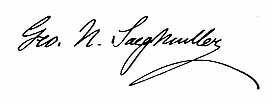
August 1929.